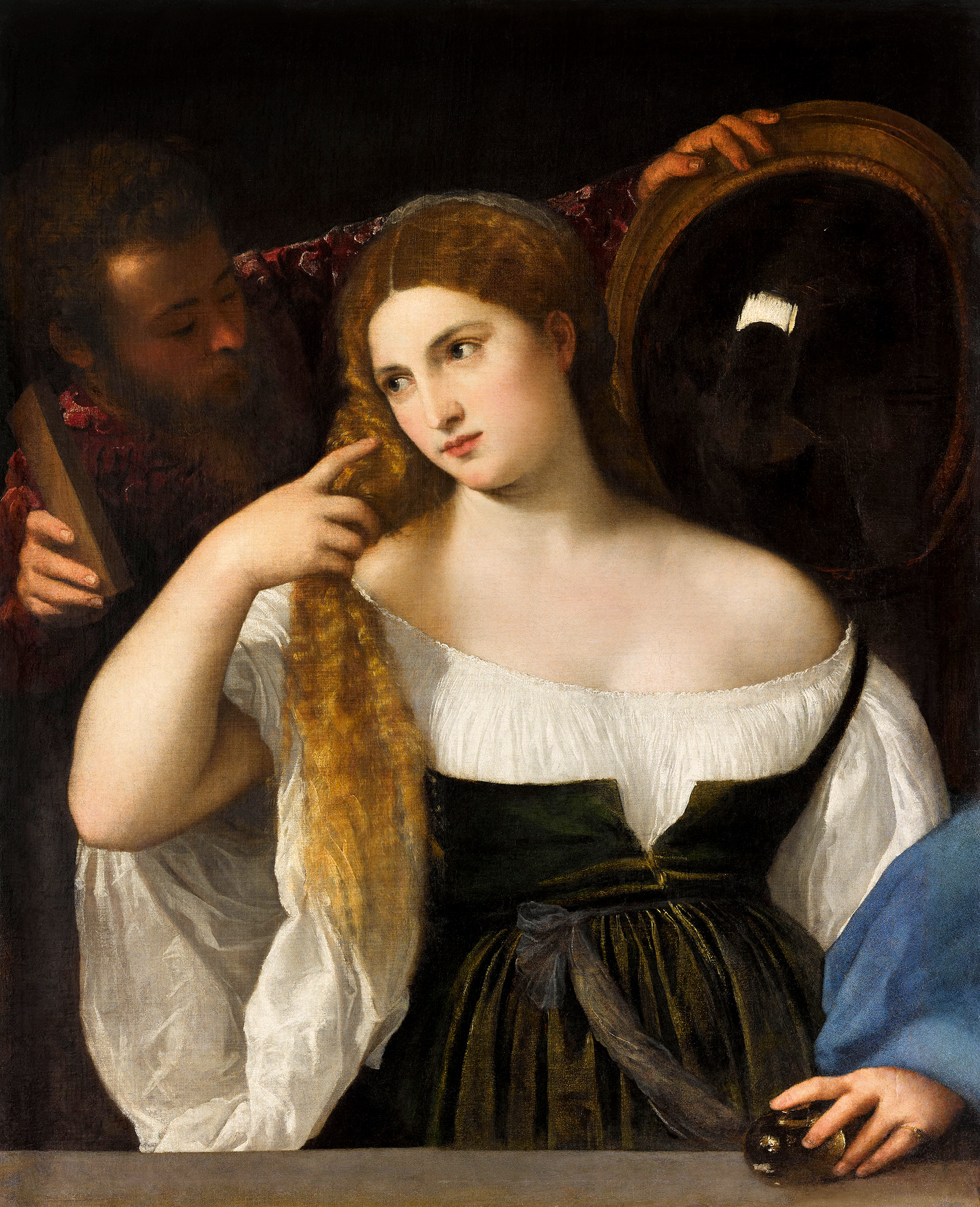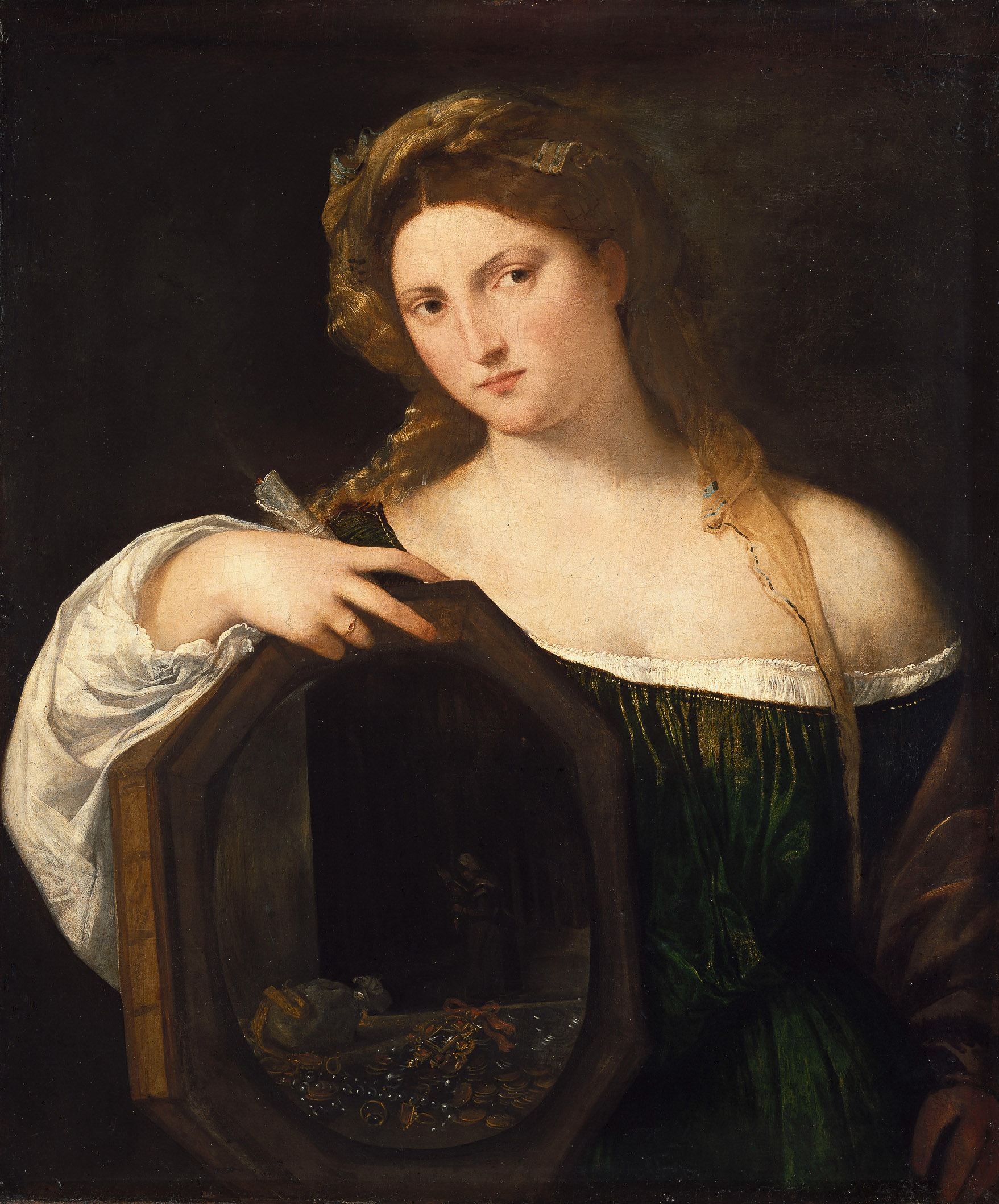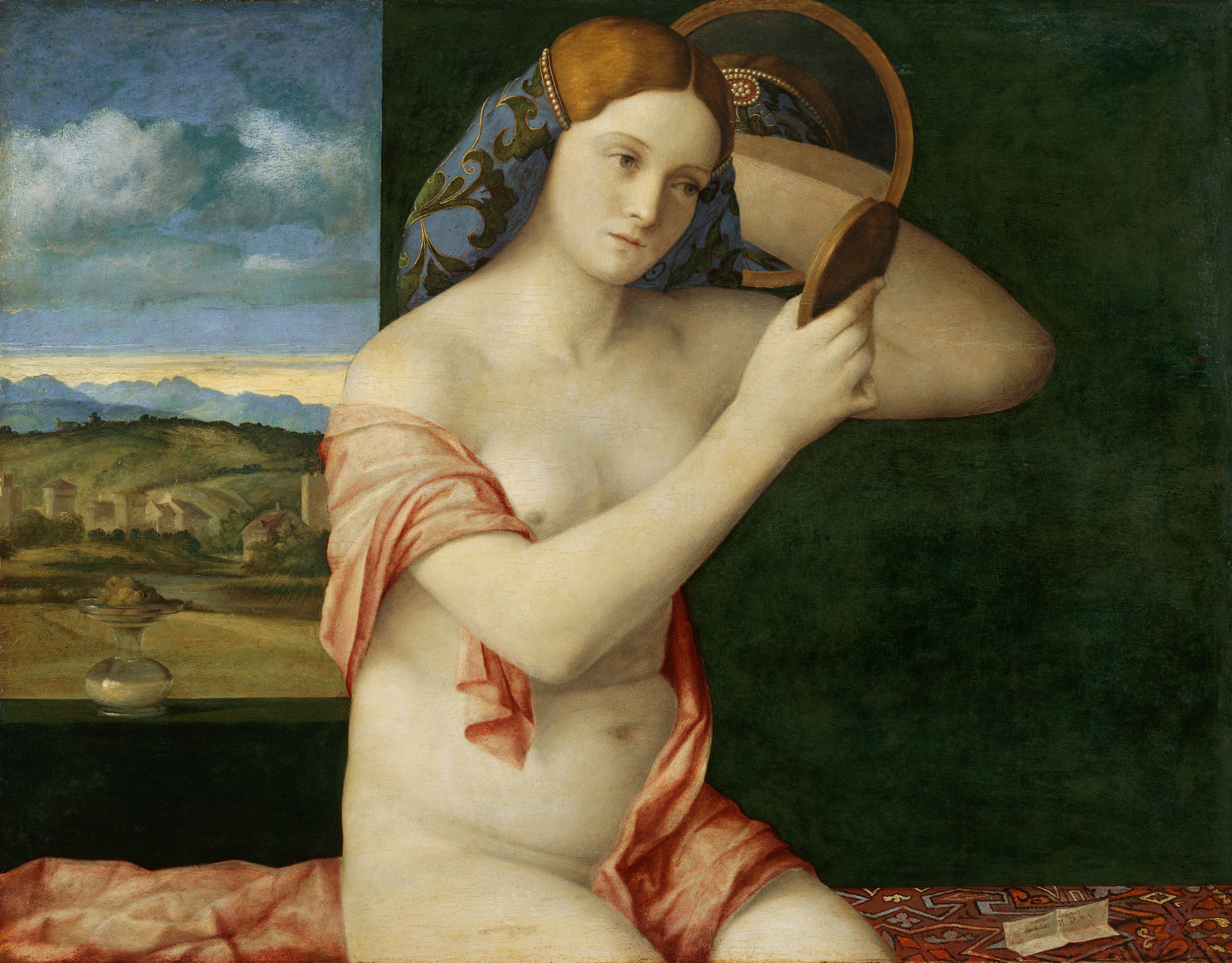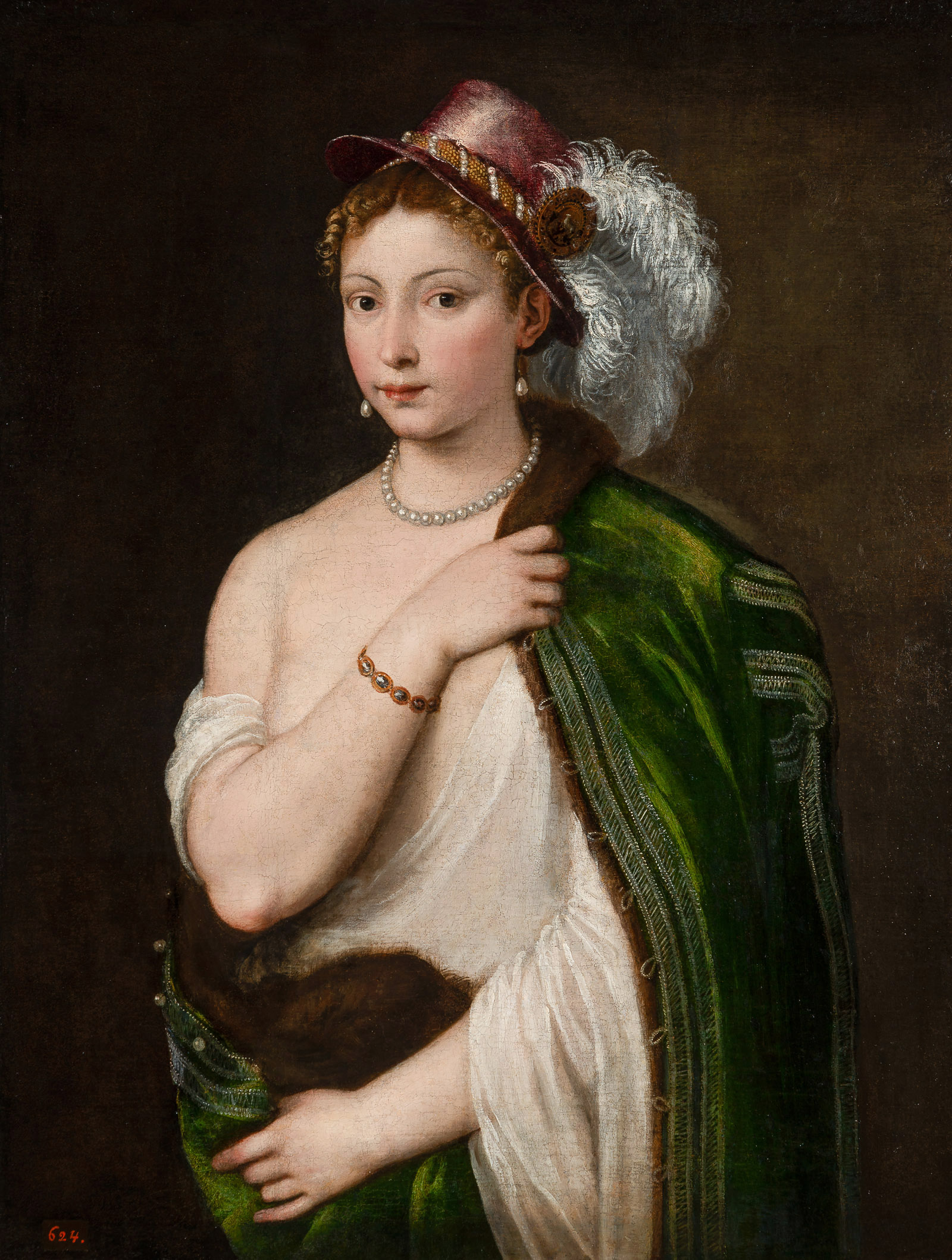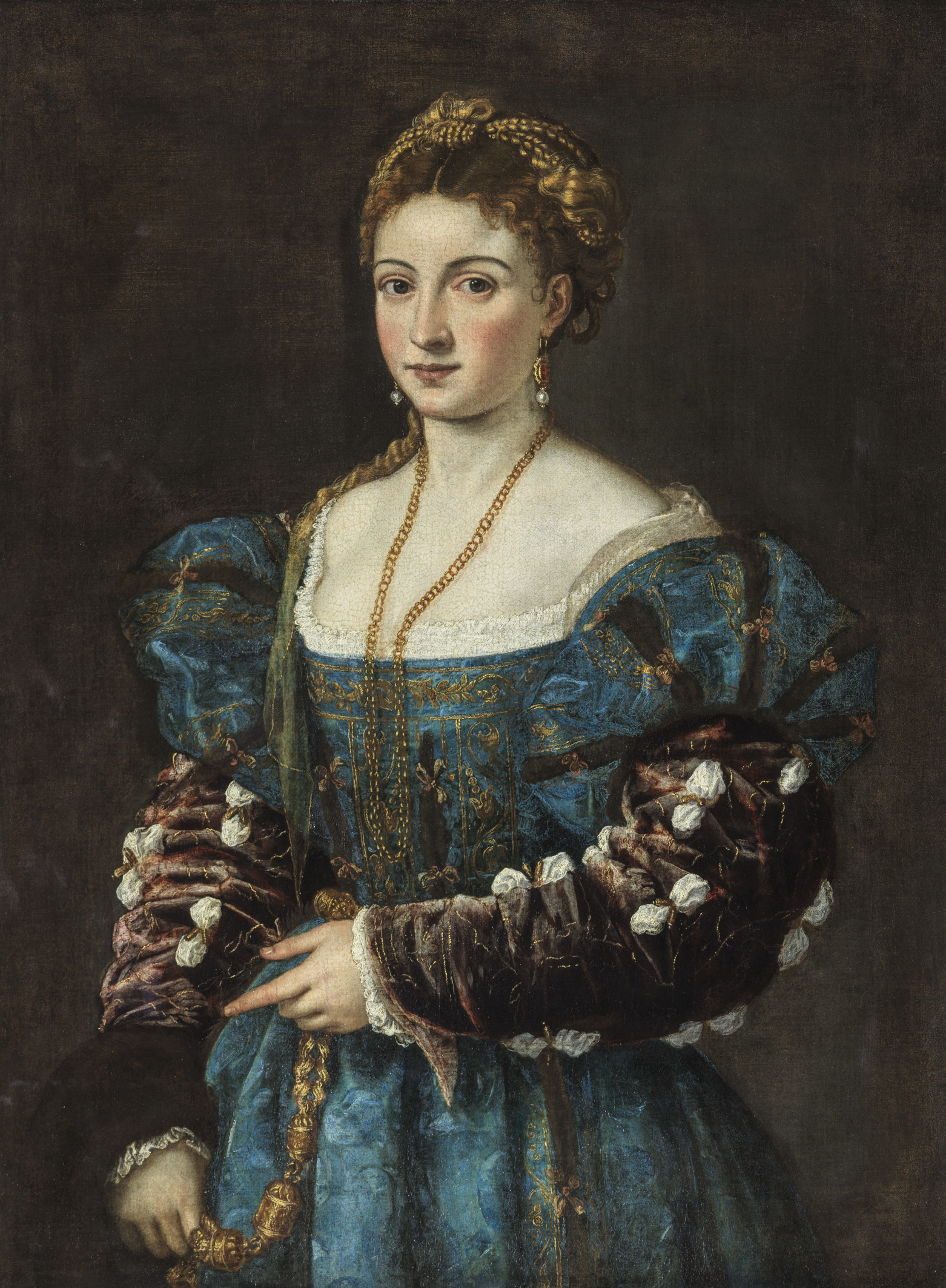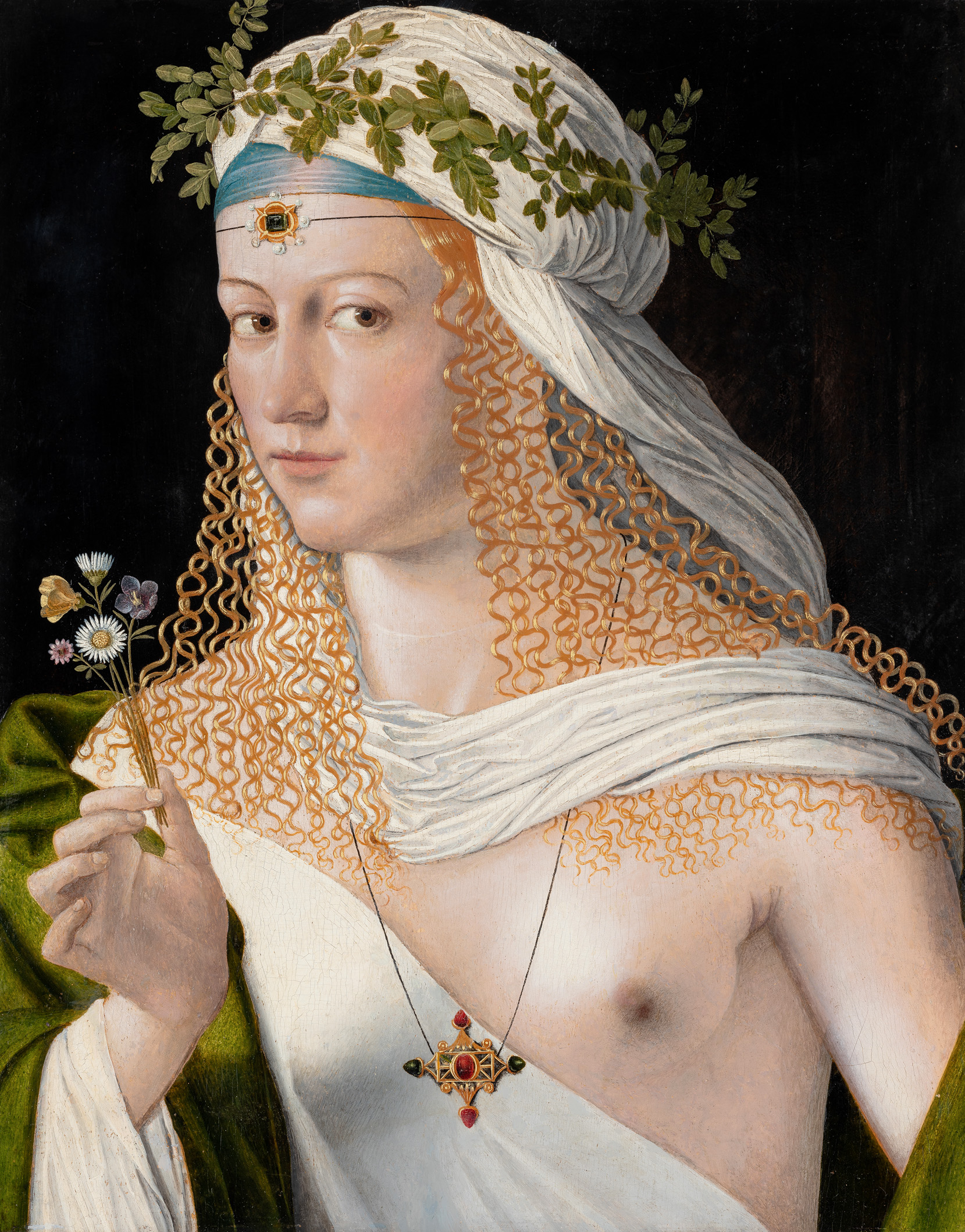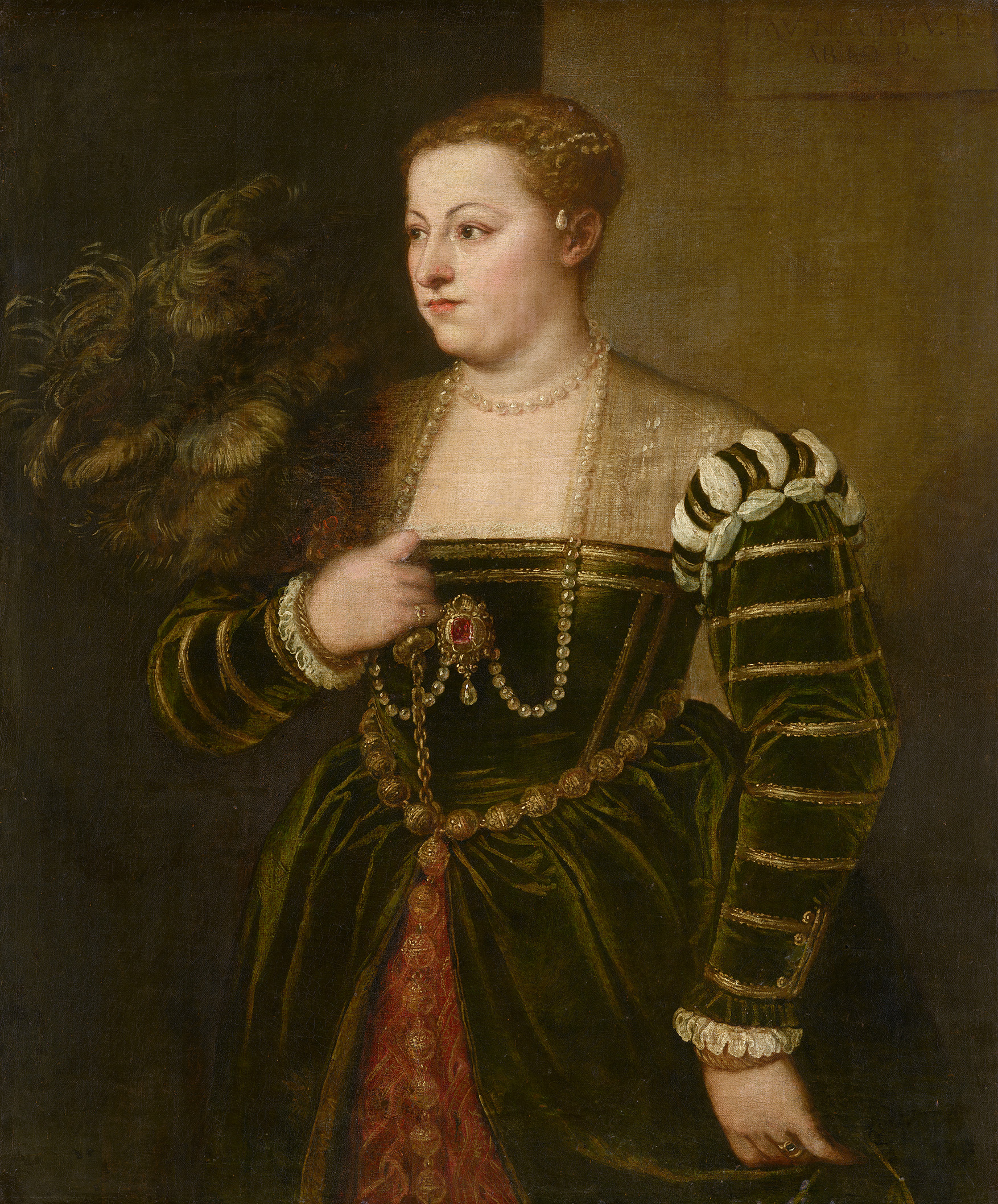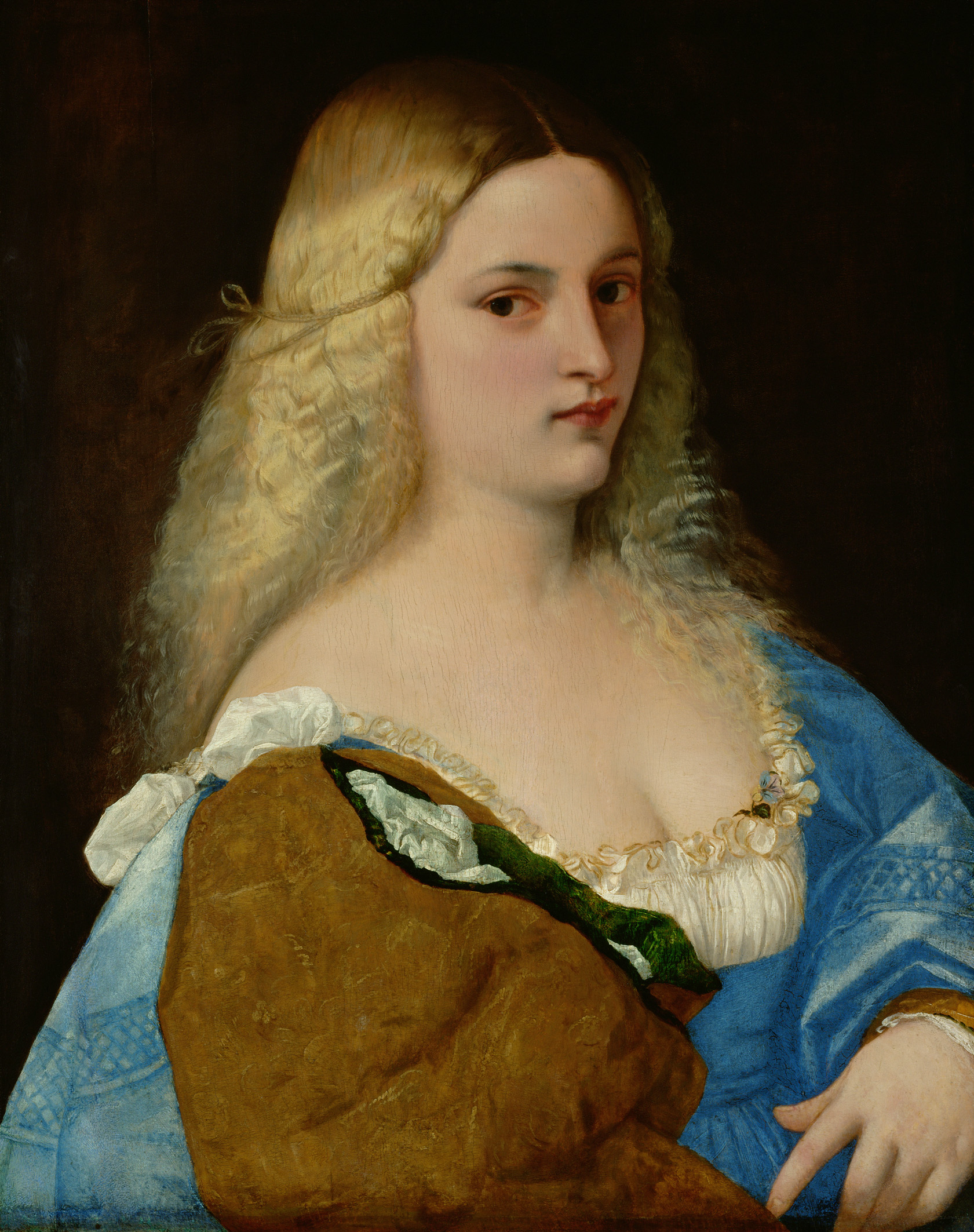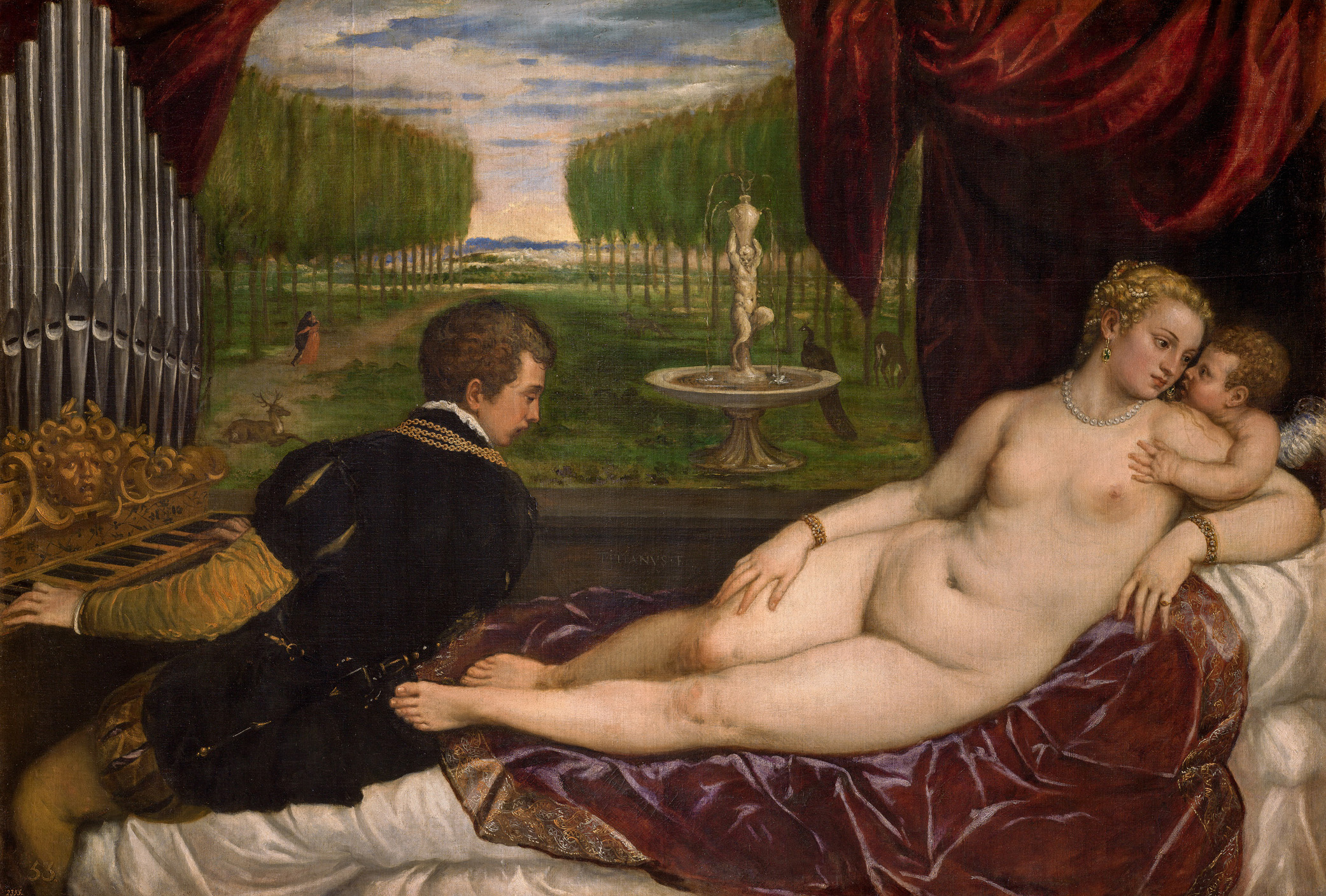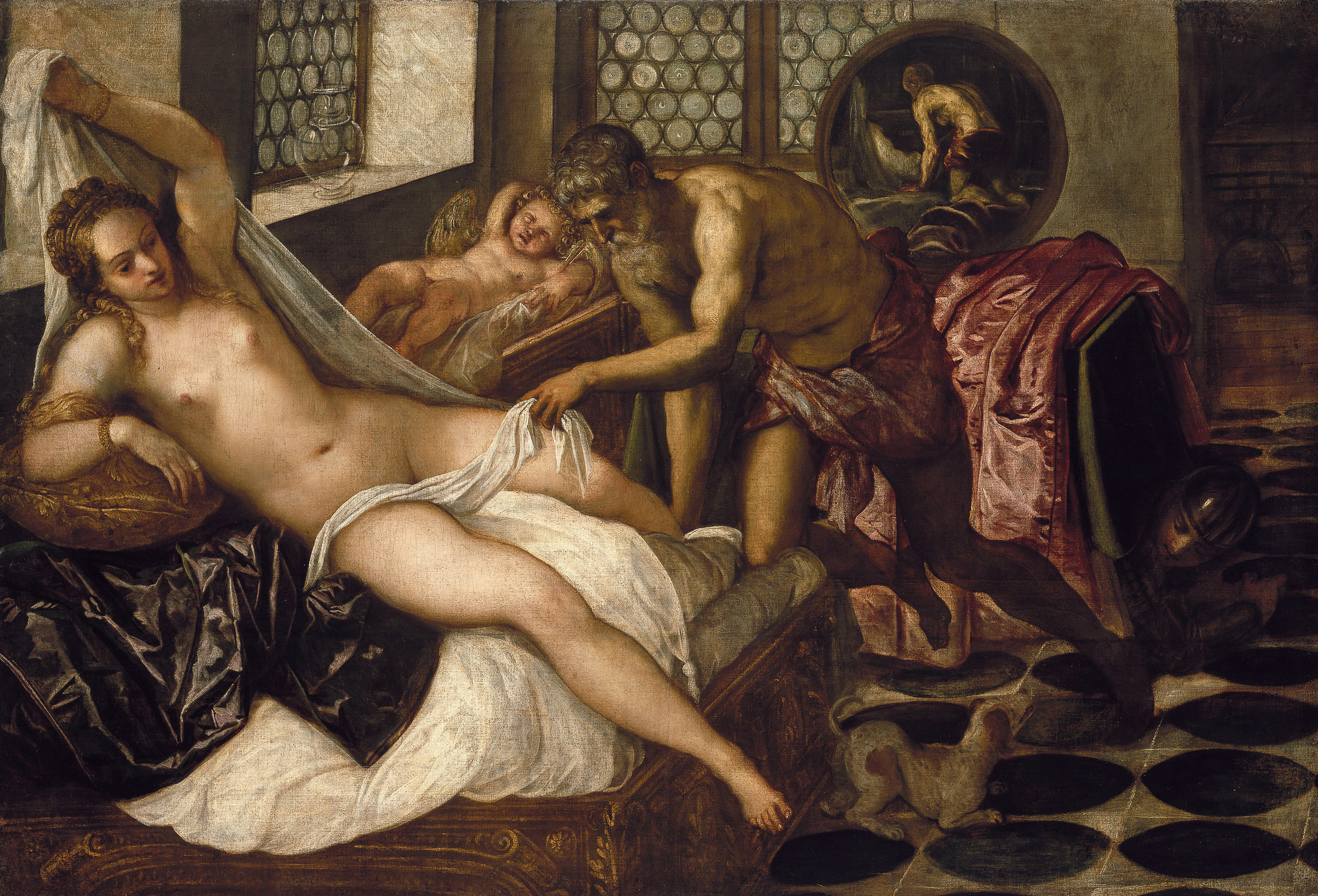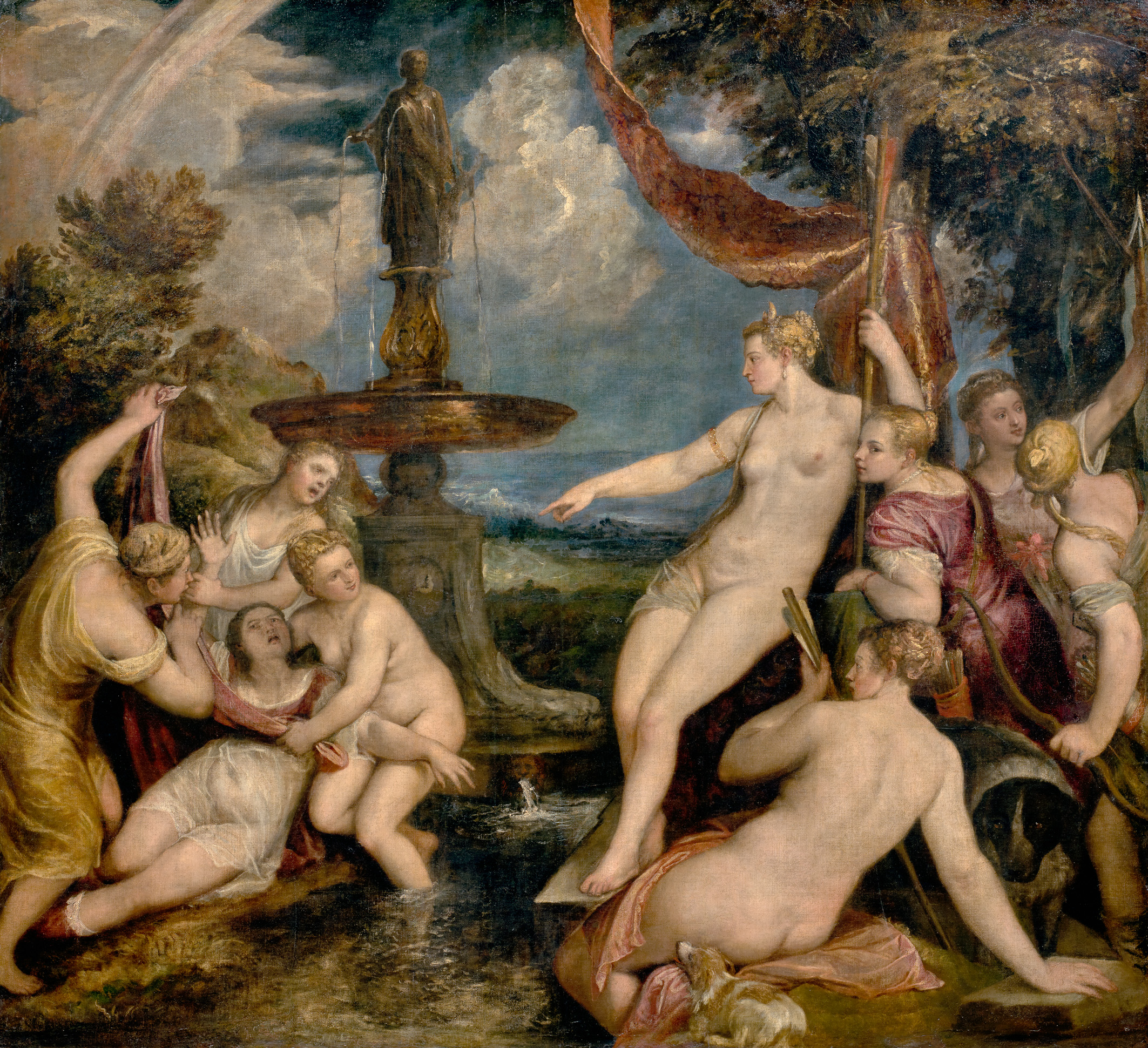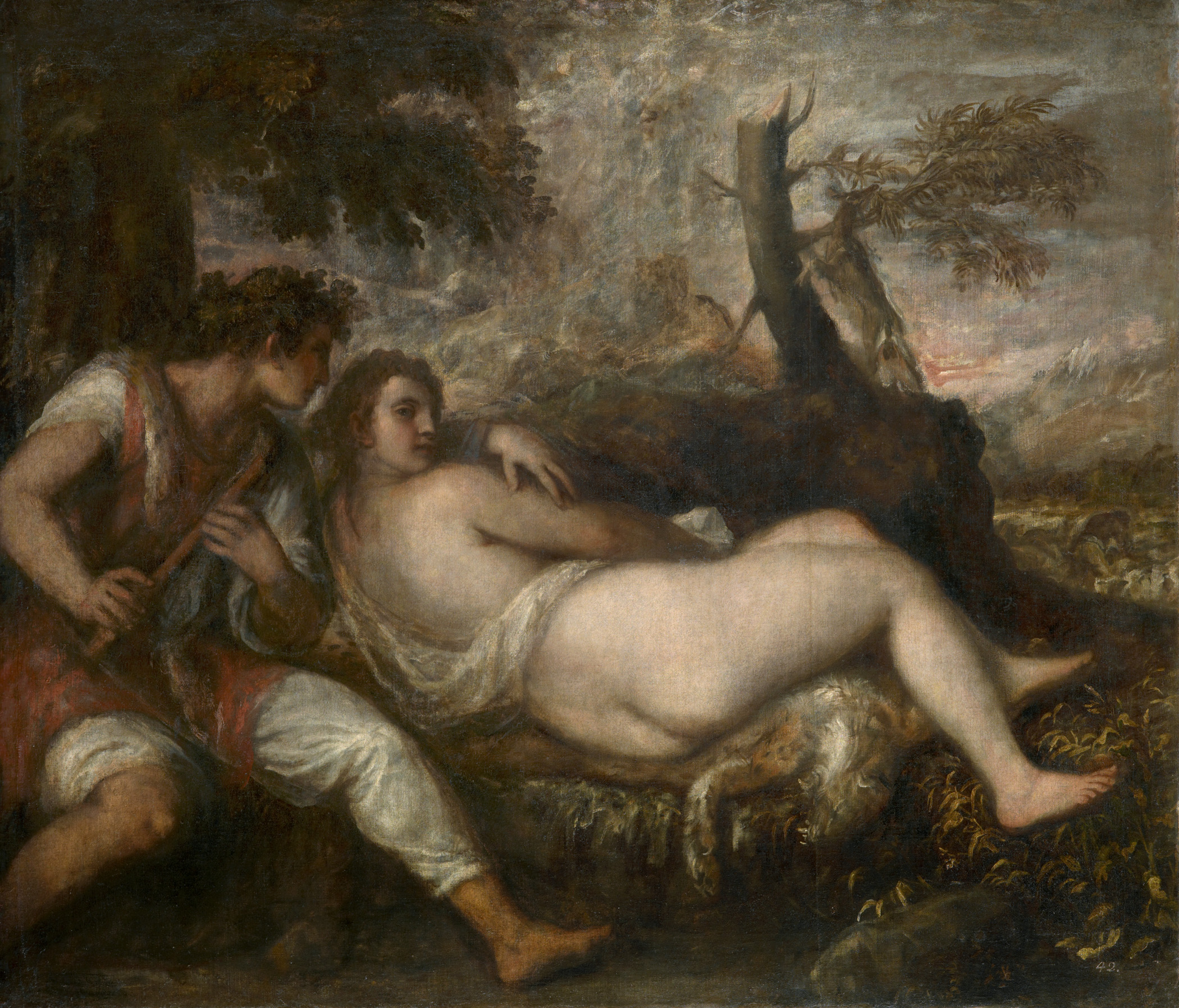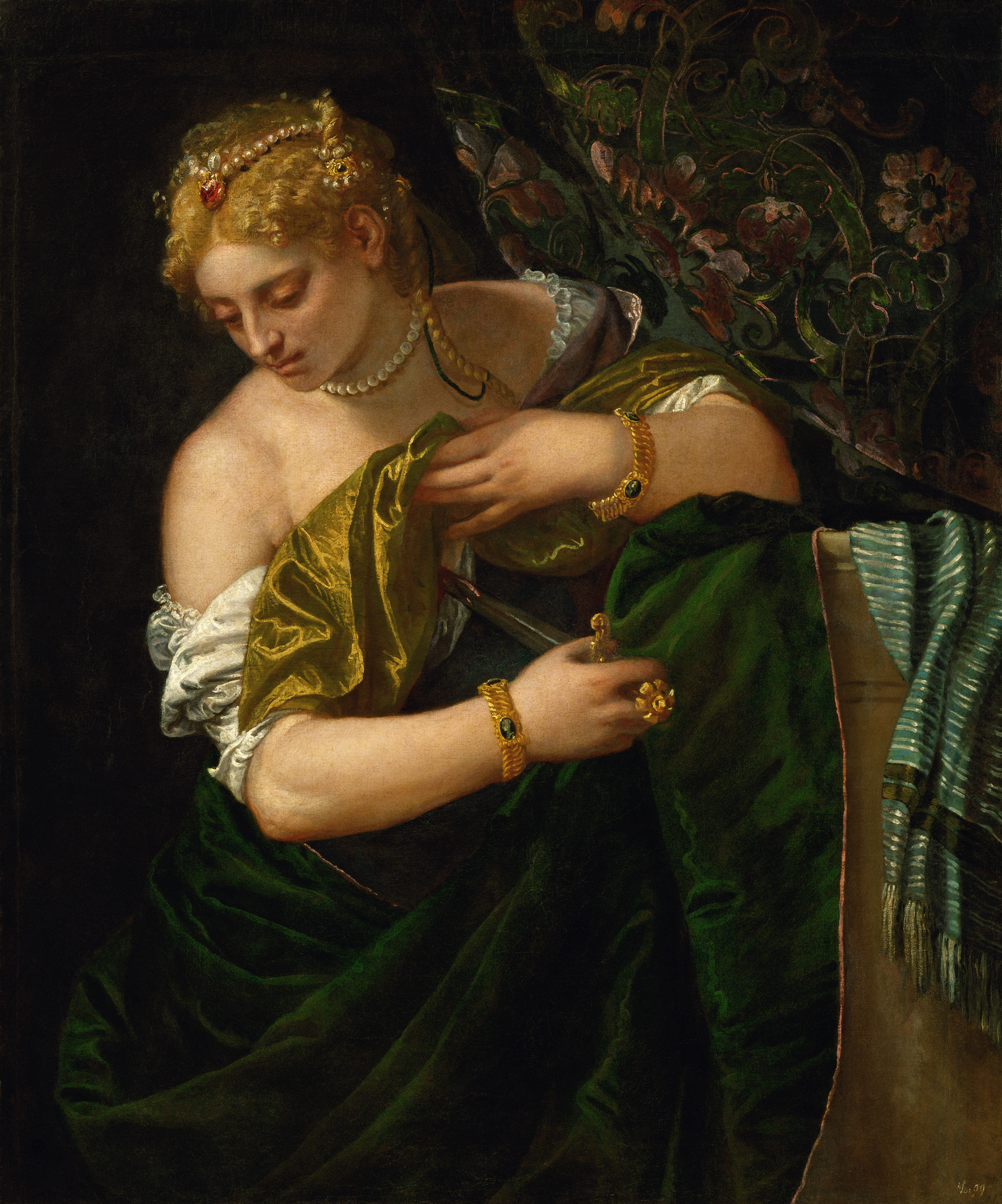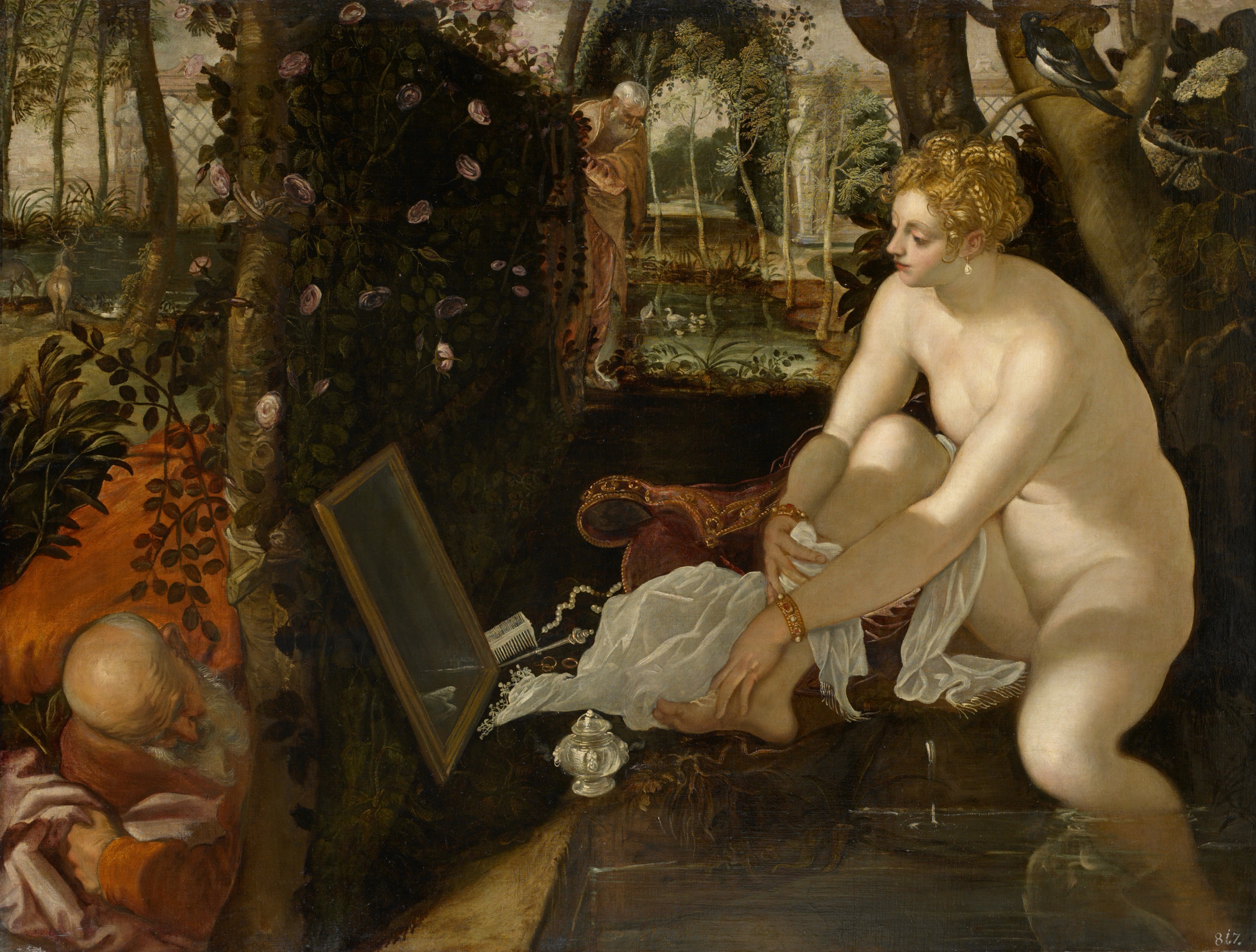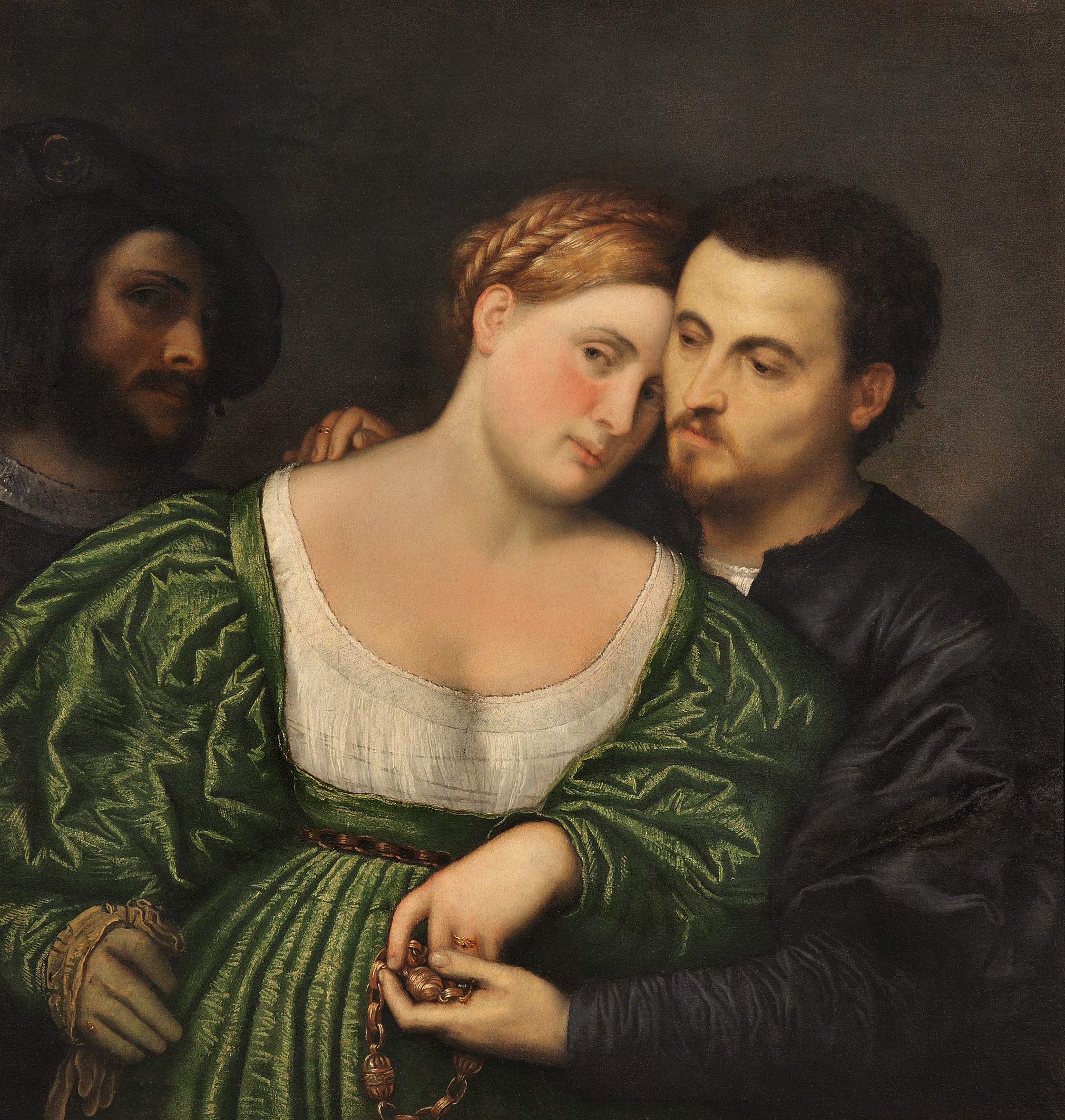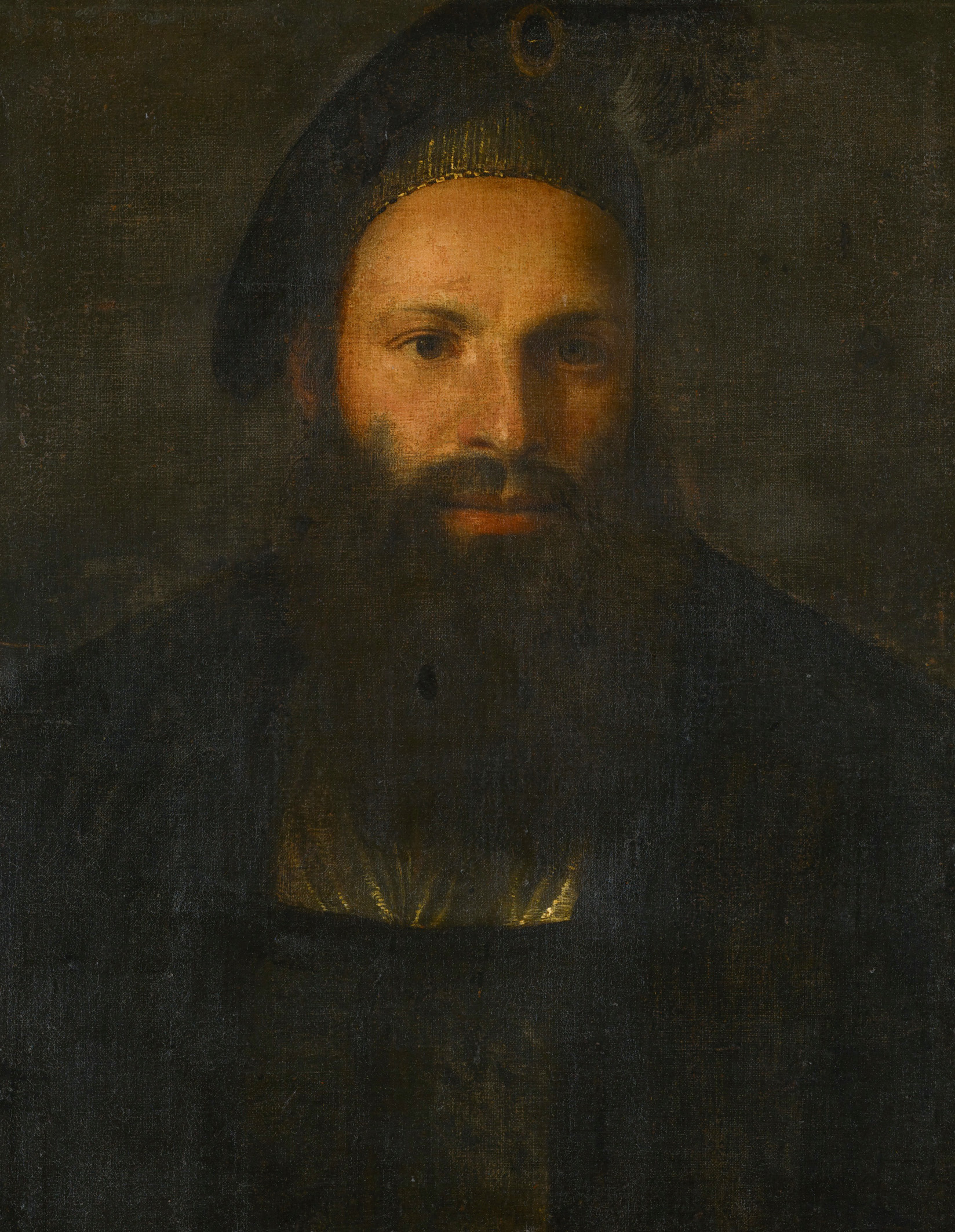Kunsthistorisches Museum
5 OCTOBER 2021 TO 16 JANUARY 2022
Each year, the Kunsthistorisches Museum dedicates its autumn show to the Old Masters. The exhibition Titian’s Vision of Women shows over sixty paintings from international as well as the museum’s own collections in order to illuminate the depiction of women in the oeuvre of the Venetian master Titian (c.1488‒1576) and his contemporaries.
Exceptional works are on loan from, among others, the Metropolitan Museum of Art in New York, the Louvre in Paris, the Prado in Madrid, the Uffizi Gallery in Florence, the Hermitage Museum in Saint Petersburg, and the Gallerie dell’Accademia in Venice. Titian and his contemporaries, including Palma il Vecchio, Lorenzo Lotto, Paris Bordone, Jacopo Tintoretto, and Paolo Veronese, were inspired by the love poetry and literature of their time to create poetic and sensual, idealizing images of women that went on to inform European painting for many centuries.
This exhibition spotlights the Venetian view of women against the backdrop of the ideals and the social realities of sixteenthcentury life. Titian’s paintings of women celebrate women as the greatest subject of life, love, and art. Women as a Subject in Painting and Literature The remarkable prominence of women in Venetian sixteenth century painting is due to a number of reasons, which include the socio-political structure of the city known as La Serenissima (women enjoyed particular rights with regard to their own dowry and inheritance), as well as the culturally open-minded and international atmosphere at the centre of the maritime republic.
Influential publishers in Venice attracted notable poets and humanists, including Pietro Bembo, Sperone Speroni, and Ludovico Dolce, whose writings frequently focused on the themes of women and love. Titian, the most significant painter to have emerged from the city-state, decisively shaped their visual representation.
New Research – New Interpretations
The women who Titian had painted looking directly at, or – worse yet – even baring or half-baring their breasts for the viewers were long supposed to have simply been courtesans. Newly inspected sources draw a much more differentiated picture of the looks and gestures that are depicted in sixteenth century paintings. Current research considers them being symbolic of a woman opening her heart to a future spouse, depicting the bride’s agreement to a proposed union. The creators of the exhibition have looked into these and other reinterpretations.
Women Demand(ed) Respect
The novel, heightened attention focused on women by painters, humanists, and poets also had an influence on the actual ways of female life in sixteenth-century Venice. The specific urban setting, Venice’s forma urbis, fostered female contacts and exchange between the different social strata. Female writers demanded that their skills be met with greater respect and that women were granted equal access to higher education in their treatises. In doing so, they prepared the ground for greater equality between women and men, raising a topic that is once again of particular global relevance.
A Multi-Faceted Exhibition
The show aims to reveal the many facets of this topic and cast a closer eye at the range of featured gestures, looks, and attributes. Ranging from concrete likenesses to idealized variations inspired by poetry, the exhibits show how interpretations of the topics of love and desire were staged in the form of historical, mythological, and allegorical depictions. Realistic and idealized portraits furthermore serve for an analysis of contemporary fashion, hairstyles as well as the valuable items created by the city’s goldsmiths. The extensive contemporary literary body of tractates and love poetry provides a solid basis for a new reading of this unique depiction of women.
Sixteenth-Century Venice
Venice reached the zenith of its exceptional development during the sixteenth century. A small aristocratic class of people, from among whom the Doge was elected, ruled the republic. However, the male and female citizens, in particular the merchants, also made a significant contribution to the city’s rise. Venice was able to make use of its situation on the Mediterranean Sea to become a hub for the trade of luxury goods from throughout the world. The city on the lagoon enjoyed a prosperity and cultural diversity that is also reflected in the period’s architecture and art. The numerous palaces and churches of Venice were fitted out with countless frescoes and paintings by such greats as Giovanni Bellini, Tintoretto, Veronese, and, not least, Titian himself.
Titian – a Brief Biography
Titiano Vecellio was born over five centuries ago in a small village in the Dolomite Alps. He moved to Venice, about a hundred kilometres away, when he was only about ten years old, and continued to live and work there until his death. As a painter, he became known by his first name Titian, using its Latin form ‘Titianus’ to sign many of his paintings. Titian is considered one of the best-known Italian artists of the sixteenth-century period known as the High Renaissance.
Titian was initially instructed at the studio of the renowned Bellini family of artists, together with his painter colleague Giorgione. Soon after he had opened his own workshop, he was elevated to the position of official state painter of the Republic of Venice. Titian married twice and was the father of four children. His altar pictures were unusually dramatic and emotive for their time, and attracted much attention in Venice. His empathic portraits of the rich and powerful soon spread Titian’s fame beyond the borders of Venice. His friend, the writer Pietro Aretino, helped him establish contacts to influential figures throughout Europe. In exchange, Titian painted his likeness several times.
In 1533, the Habsburg emperor Charles V appointed Titian his court painter. Titian continued to work mostly from Venice, but travelled to Augsburg twice on imperial orders. Titian also spent several months in Rome as a guest of Pope Paul III. Titian’s typical manner of modeling shapes by light and colour in his paintings was met with admiration as well as criticism in Rome.
In his later works, Titian usually applied the paint with thick brushstrokes in several layers, so that the process in which he created his paintings remains visible. This experimental use of paint, however, was little understood in his time. His paintings, which now appear remarkably modern, were greatly influential for the further development of European painting.
Titian, who is assumed to have lived to long past his eightieth birthday, died in 1576 during an epidemic of the Buconic plague in Venice.
Impressive International Loans Join the Abundant Collections of the Kunsthistorisches Museum Vienna
Exceptional loans from international museums and private collections join selected works of the Kunsthistorisches Museum to illuminate the many facets of this subject. The Kunsthistorisches Museum Picture Gallery is matched by few other museums in the world in holding such a rich array of Venetian depictions of women from the sixteenth century. Loans of renowned works were contributed, among others, by the Metropolitan Museum of Art in New York, the Louvre in Paris, the Prado and the Thyssen-Bornemisza Collection in Madrid, the Uffizi Galleries in Florence, the National Gallery in London, the Ashmolean Museum in Oxford, the Hermitage Museum in St Petersburg, the Gallerie dell’Accademia in Venice, the Galleria Borghese in Rome, the Museo Nazionale di Capodimonte and the Museo Archeologico Nazionale in Naples, the Staatliche Museen zu Berlin, the Bayerische Staatsgemäldesammlung, Alte Pinakothek in Munich, the Staatliche Kunstsammlungen in Dresden, the Kunstmuseum Basel, as well as private lenders.
Idea and exhibition concept: Sylvia Ferino-Pagden Curators: Sylvia Ferino-Pagden, Francesca Del Torre Scheuch and Wencke Deiters
Exhibition design: Gerhard Veigel The exhibition is on show at the Kunsthistorisches Museum in Vienna and subsequently at the Palazzo Reale in Milan. Publication and Website This exhibition is accompanied by an extensive publication in German and English.
Published at the Milan publishing company Skira, it includes contributions from numerous internationally renowned Titian experts and is edited by Sylvia Ferino-Pagden, Francesca Del Torre Scheuch, and Wencke Deiters.
Images
Titian (c.1488–1576) Young Woman at Her Toilet c.1515 canvas, 99 × 76 cm Musée du Louvre, Département des Peintures, Paris © RMN-Grand Palais (musée du Louvre) / Franck Raux
Titian (c.1488–1576) Vanitas c.1520 canvas, 97 × 81,2 cm Alte Pinakothek, Munich © bpk / Bayerische Staatsgemäldesammlungen
Giovanni Bellini (c.1433–1516) Young Woman at Her Toilet 1515 poplar panel, 62,9 × 78,3 cm Kunsthistorisches Museum Vienna © KHM-Museumsverband
Titian (c.1488–1576) Young Woman with a Plumed Hat 1534/36 canvas, 96 × 75 cm The State Hermitage Museum, St Petersburg © The State Hermitage Museum, 2021, Photo: Dmitri Sirotkin
Titian (c.1488–1576) Portrait of a Lady in Blue (“La Bella”) 1534/36 canvas, 89 × 75,5 cm Gallerie degli Uffizi, Florence © Galleria Palatina e Appartamenti Reali di Palazzo Pitti, su concessione del Ministero della cultura
Titian (c.1488–1576) Young Woman in a Fur 1534/36 canvas, 95,5 × 63,7 cm Kunsthistorisches Museum Vienna © KHM-Museumsverband
Bartolomeo Veneto (?–1531) Flora c.1520 poplar panel, 43,6 × 34,6 cm Städel Museum, Frankfurt am Main © Städel Museum, Frankfurt am Main
Titian (c.1488–1576) Flora c.1517 canvas, 79,7 × 63,5 cm Gallerie degli Uffizi, Florenz © Galleria Palatina e Appartamenti Reali di Palazzo Pitti, su concessione del Ministero della cultura
Titian (c.1488–1576) Potrait of Lavinia c.1565 canvas, 103 × 86,5 cm Staatliche Kunstsammlungen Dresden © Gemäldegalerie Alte Meister, Staatliche Kunstsammlungen Dresden, Photo: Elke Estel/Hans-Peter Klut
Titian (c.1488–1576) Isabella d’Este, Marchioness of Mantua (1474–1539) 1534/36 canvas, 102,4 × 64,7 cm Kunsthistorisches Museum Vienna © KHM-Museumsverband
Titian (c.1488–1576) Violante 1510/14 poplar panel, 64,5 × 50,8 cm Kunsthistorisches Museum Vienna © KHM-Museumsverband
Palma il Vecchio (1480–1528) Portrait of a Young Woman, known as “La Bella” 1518/20 canvas, 95 × 80 cm Museo Nacional Thyssen-Bornemisza, Madrid © Museo Nacional Thyssen-Bornemisza, Madrid
Titian (c.1488–1576) Clarissa Strozzi (1540–1581) 1542 canvas, 121,7 × 104,6 cm Staatliche Museen zu Berlin © bpk / Staatliche Museen zu Berlin, Gemäldegalerie / Christoph Schmidt
Jacopo Tintoretto (1518/19–1594) The Fall (Adam and Eve) 1550/53 canvas, 150 × 220 cm Gallerie dell’Accademia, Venice © Gallerie dell’Accademia di Venezia, "Ministero della Cultura"
Titian (c.1488–1576) Venus with an Organist and Cupid c. 1555 canvas, 148 × 217 cm Museo Nacional del Prado, Madrid © Archivo Fotográfico. Museo Nacional del Prado, Madrid
Jacopo Tintoretto (1518/19–1594) Vulcan Surprising Venus and Mars c.1555 canvas, 135 × 198 cm Alte Pinakothek, Munich © bpk / Bayerische Staatsgemäldesammlung
Paolo Veronese (c.1528–1588) The Rape of Europa c.1578 canvas, 234 × 320 cm Palazzo Ducale, Fondazione Musei Civici di Venezia Foto: Matteo De Fina 2019 © Archivio Fotografico – Fondazione Musei Civici di Venezia
Titian and workshop Diana and Callisto c.1566 canvas, 183 × 200 cm Kunsthistorisches Museum Vienna © KHM-Museumsverband
Titian (c.1488–1576) Nymph and Shepherd 1570/75 canvas, 149,6 × 187 cm Kunsthistorisches Museum Vienna © KHM-Museumsverband
Paolo Veronese (c.1528–1588) Judith c.1580 canvas, 111 × 99,8 cm Kunsthistorisches Museum Vienna © KHM-Museumsverband
Paolo Veronese (c.1528–1588) Lucretia 1580/83 canvas, 109,5 × 90,5 cm Kunsthistorisches Museum Vienna © KHM-Museumsverband
Jacopo Tintoretto (1518/19–1594) Susanna Bathing c.1555/56 canvas, 146 × 193,6 cm Kunsthistorisches Museum Vienna © KHM-Museumsverband
Paris Bordone (1500–1571) The Lovers 1525/30 canvas, 81 × 86 cm Pinacoteca di Brera, Milan © Pinacoteca di Brera, Milano
Titian (c.1488–1576) Pietro Aretino 1527? canvas, 58,5 × 46,5 cm Kunstmuseum Basel © Kunstmuseum Basel, Martin P. Bühler
Exhibits
In this exhibition, woman is shown mainly in the profane context. But as Eve and Mary, biblical figures from the Old and New Testaments, had a definitive impact on the role of women in Christian society, we confront visitors with them at the start in two magnificent paintings by Titian and Tintoretto (nos. 1, 2). Repeatedly dwelt on by misogynistic doctors of the church, Eve’s culpability for the expulsion from Paradise was discussed by erudite women in the sixteenth century, becoming an important subject of argumentation in the Querelle des femmes, a literary proto-feminist current of this time.
GALLERY 1
Jacopo Tintoretto (1518/19–1594) THE FALL (ADAM AND EVE) 1550/53 Oil on canvas Venice, Gallerie dell’Accademia di Venezia
While the Bible’s first account of the creation (Genesis 1: 26–31) gives the first woman the same status as the first man, the second account (2: 18–25) makes Eve subordinate to Adam, putting the blame on her for eating the forbidden fruit of the Tree of Knowledge and persuading Adam to follow suit. So it was that Eve was held responsible for the expulsion from Paradise. The counter-figure to Eve is the Virgin Mary, whose son was to offer himself up for the redemption of mankind condemned through Eve’s sin. These two female figures played a defining role in staking out the parameters for woman’s role in Christian society.
Titian (c.1488–1576) MADONNA AND CHILD IN FRONT OF A COLOURFUL CLOTH OF HONOUR 1511 Oil on panel Kunsthistorisches Museum Vienna, Picture Gallery
This painting is probably Titian’s first significant Madonna and Child. While on the one hand he humanizes the Virgin, on the other he elevates the scene to a higher level through the bucolic landscape, drenched in the evening sun. The abandonment of a strong symmetry and the modelling of the body through highlights and shadows signalize the departure from the style of Titian’s teacher Giovanni Bellini.
‘LE BELLE VENEZIANE’
The artistic genre of the ‘Venetian belles’ emerged at the beginning of the sixteenth century and featured halflength figural depictions, some closer to the realistic portrait and others to idealization but all marked by an alluring sensual beauty. Whether they look directly at or past the viewer, the women are shown in an intimate setting, busying themselves with such things as their hair or their clothing, and often seem to have been caught unawares. Although these paintings were for a long time thought to be portraits of courtesans, more recent research has shown that they are more commonly poetic depictions of brides or newly-weds.
Titian (c.1488–1576) YOUNG WOMAN IN A BLACK DRESS c.1514/15 Oil on poplar panel Kunsthistorisches Museum Vienna, Picture Gallery This profoundly intimate portrait shows a young lady looking with candid affection out at the beholder and making an entirely unpretentious and natural impression. The fact that her fine white chemise has slipped alluringly off her left shoulder makes her seem vulnerable, though her direct look and firmly held right arm generate an air of relaxed self-assurance. The fur-collared cloak and fine wavy hair falling loose behind her shoulders underline 3 the private character of this sensual depiction, which almost has something of a modern snapshot about it.
Titian (c.1488–1576) VIOLANTE 1510/14 Oil on poplar panel Kunsthistorisches Museum Vienna, Picture Gallery This young lady is thought to be the earliest of Titian’s belle donne and was given her name on account of the violet – a delicate flower associated with virginity and the innocence of young brides – that nestles charmingly in her décolletage. That she wears her blonde hair loose also suggests that she is a young sposa, as does the V formed by fingers of her left hand, which could stand either for Venus or for virtus, or both. Although she looks at us somewhat distrustfully, she does so without any shyness.
Palma il Vecchio (c.1480–1528) YOUNG WOMAN IN A GREEN DRESS WITH A BOX IN HER HAND 1512/14 Oil on poplar panel Kunsthistorisches Museum Vienna, Picture Gallery
That the subject of this painting was a young bride is strongly suggested by the gimmel ring with one red and one green gemstone and by the box from which issue the ‘bands of love’ as manifestations of the otherwise invisible bonds of affection. The colour of her skilfully braided hair is echoed in accents of her splendid dress, complementing the dark green that emanates a general air of harmony. Typical of Palma Vecchio, a follower of the Petrarchan ideal of beauty, are the milky tone of the flesh, velvety softness of the skin, and fine hands.
Palma il Vecchio (c.1480–1528) PORTRAIT OF A YOUNG WOMAN IN PROFILE 1520/25 Oil on poplar panel Kunsthistorisches Museum Vienna, Picture Gallery
Although this painting is considered unfinished, it is marked by a highly original composition which betrays the influence of Lorenzo Lotto’s portraits but for which 5 6 Palma Vecchio must nevertheless be given the credit and acclaim. The young woman looks somewhat downwards over her shoulder at the viewer. She seems to be busy doing her hair, which gives the picture a certain intimacy. Her self-assured expression has something seductive about it, very likely for the benefit of the (presumably male) individual who commissioned the work.
Palma il Vecchio (c.1480–1528) YOUNG WOMAN IN BLUE DRESS WITH FAN 1512/14 Oil on poplar panel Kunsthistorisches Museum Vienna, Picture Gallery
Like Palma Vecchio’s lady in green (no. 5), this somewhat mistrustful-looking young woman is wearing a double ring. That it is in all probability a betrothal ring is confirmed by the veil she holds in her left hand and the V she forms with her fingers, possibly standing for virtus. Like Titian’s Violante, she is adorned with a violet, shyly hidden in her hair in allusion to her virginal innocence. The blue bodice, delicate white chemise, and elegant fan in her right hand all suggest that she belongs to a highly fashion-conscious social elite.
Palma il Vecchio (c.1480–1528) PORTRAIT OF A YOUNG WOMAN KNOWN AS ‘LA BELLA’ 1518/20 Oil on canvas Madrid, Museo Nacional Thyssen-Bornemisza
\This painting, a major work of Palma Vecchio’s long attributed to Titian, shows a woman between reality and idealization. Her sumptuous dress, the unapproachability generated by her bearing and position behind a parapet, the palace architecture, her majestic elegance – all these things combine to make the painting a timeless image of gracious femininity. Nevertheless, it is quite possible that the subject was a specific woman: the little casket reveals not only bands symbolizing the bonds of love but also a finely wrought gold chain, which may have been a gift from her bridegroom. The relief in the top right-hand corner showing a naked man being overcome by a rider is to be interpreted as an exhortation to rein in the urges of lustful desire
Giovanni Bellini (1430/35–1516) YOUNG WOMAN AT HER TOILET 1515 Oil on poplar panel Kunsthistorisches Museum Vienna, Picture Gallery
This poetic and contemplative painting makes the viewer – almost voyeuristically – party to a highly private scene. 10 The young lady, idealized to the extent that her body almost seems made of stone, is gazing into a mirror. Deeply engrossed in her own reflection, she is gathering her hair into an exceptionally elegant embroidered snood decorated with pearls. This may indicate that she is newly wed – having hitherto worn her hair down, now she has to put it up, as was customary for married women.
Titian (c.1488–1576) YOUNG WOMAN AT HER TOILET c.1515 Oil on canvas Paris, Musée du Louvre
The scene we are witness to is an intimate one: a woman combs and perfumes her hair. As she does so, she looks into a mirror held for her by a man, who is also holding a second mirror enabling her to see herself from behind. This time we too are able to see the reflection. Is Titian perhaps entering into a contest with the sculptors, whose works make it possible to look at a figure from all sides? Or did he draw inspiration from poetry, in which the motif of hair was frequently associated with the theme of love? Or was he motivated by his teacher Giovanni Bellini’s painting showing a similar scene (no. 10)? As it has still not been established who this woman is, the picture remains an enigma. What would your interpretation be?
Titian (c.1488–1576) VANITAS c.1520 Oil on canvas Munich, Alte Pinakothek
The young woman looks out at us with an expression of self-assurance. She holds a mirror up for us to look into, reminding us of the transience of youth and beauty, a truism underlined by the snuffed-out candle she holds between her thumb and index finger. The jewellery and coins seen in the mirror were added by Titian around thirty years later – riches are no less transient than youth and beauty. Might this be the same woman as the one seen in the painting exhibited to the left (no. 11)? Paris Bordone (1500–1571) PORTRAIT OF A YOUNG WOMAN AT HER DRESSING TABLE c.1550 Oil on canvas Kunsthistorisches Museum Vienna, Picture Gallery Paris Bordone’s strong, almost masculine women carry on the Venetian tradition of the belle donne well into the second half of the sixteenth century. With her majestic head of plaited hair and muscular arms, this is a young 12 13 lady of considerable self-assurance, though with her reddish cheeks and gracious facial features she still possesses a charming femininity. Furthermore, the delicate ‘paternoster’ belt shows that she is newly wed. She is looking distrustfully at a mirror – possibly evoking the northern tradition in which the looking glass was a symbol of vanity and regarded as a source of diabolical visions. Mario Equicola (1470–1525) DE NATURA DE AMORE Venice (printed by Lorenzo Lorio Da Portes), 1525 Vienna, Austrian National Library, Department of Manuscripts and Rare Books This treatise is dedicated to Isabella d’Este (see no. 27) at whose court Equicola was secretary. He owed this position to his book De mulieribus (‘About Women’) published in 1501, in which he paid particular tribute to Isabella. In the present work On Nature and On Love, his most famous, he concerns himself with, among other things, courtly love, also touching upon the right proportions between various parts of the body, as shown in the illustration exhibited here. 14 GALLERY 1 GALLERY 1 Agnolo Firenzuola (1493–1543) DIALOGO DELLE BELLEZZE DELLE DONNE, IN: PROSE Florence, 1548 Vienna, Austrian National Library, Department of Manuscripts and Rare Books Firenzuola’s Dialogue on the Beauties of Women is the most famous work on this theme published in the Renaissance, demonstrating that it could be the topic of a treatise just like a scientific subject. In the discussion of individual parts of the body (eyes, mouth, arms, legs, etc.) beauty is considered in terms of qualities such as grace and charm. The female body is compared to vases, the one displayed on the left here with a long slender neck corresponding to an ideal female type.
FROM THE PORTRAIT TO THE EROTICALLY CHARGED IDEAL LIKENESS
These three paintings demonstrate very well how Titian developed and re-developed his pictorial inventions. The X-ray images of the painting preserved in Vienna (no. 17) show that the artist had to a large extent made ready to execute an exact copy of the Lady in Blue that is preserved in Florence (no. 16) but subsequently changed course, transforming the motif of the sumptuously attired bella into the ladies wearing pearls, jewellery and precious furs, who are likewise lavishly clad but show an increasing amount of bare flesh (nos. 17, 18). This scenario throws up many important questions related to the processes underlying Titian’s depictions of women. Were they commissions? Or were they independent inventions for which Titian in this case used the same model who sat for the Venus of Urbino?
Titian (c.1488–1576) PORTRAIT OF A LADY IN BLUE (‘LA BELLA’) 1534/36 Oil on canvas Florence, Gallerie degli Uffizi This portrait, one of Titian’s major works, is presumably the earliest in the ‘trilogy’ in which the artist presented the same model in three different ways (nos. 16–18). 16 GALLERY 1 GALLERY 1 While ‘La Bella’ is shown in noble dress, she seems not to have been any particular noble lady: had this been the case, it is improbable that Titian would have used her as a model for his increasingly erotic later works. It is possible that he put the painting on display at his studio as a kind of ‘teaser’ for visitors, in order to show them his gift for capturing female beauty and induce them to place a commission. It was probably at Titian’s studio that Francesco Maria della Rovere saw this work, to which he later referred specifically in a letter Titian (c.1488–1576) YOUNG WOMAN IN A FUR 1534/36 Oil on canvas Kunsthistorisches Museum Vienna, Picture Gallery X-ray images show this painting’s underlying composition to be the same as that of the bella preserved in Florence, who wears festive dress and a string of pearls (no. 16). It is possible that the artist took the latter work as his point of departure but subsequently decided to make his subject more idealized and also more erotically charged. The pearls and gold in her jewellery indicate that she comes from a family of financial means. Seductively, the man’s fur cloak covers her left breast but reveals, further from the beholder, her right one. In Titian’s day, furs were a much-loved gift from men to their wives. While the pos17 ition in which the subject is holding her arms is reminiscent of the Venus pudica and thus an allusion to the goddess of love and suggestive of a certain modesty, this interpretation is contradicted by the self-assured look in the subject’s eyes. Titian (c.1488–1576) YOUNG WOMAN WITH A PLUMED HAT 1534/36 Oil on canvas St Petersburg, The State Hermitage Museum The X-ray image of this painting reveals the same underlying composition as its Vienna counterpart (no. 17), demonstrating once again the skill and innovation Titian brought to the constant re-invention of his belle donne. The young woman is holding the fur-lined, green velvet cloak with an awkward grasp, giving the impression that it might soon fall to leave her in nothing but her white undergarment. The erotic charm of this picture also lies in the stark contrast between the well-illuminated flesh tone and the dark, masculine hue of the cloak, a garment also worn both by courtesans and by patrician women. The little pink hat decorated with extravagant ostrich feathers alludes to a Venetian festal dance. 18 GALLERY 1 OPENING THE HEART All the women in this section’s paintings (nos. 19–23) are seen baring the breast. It was long thought that this could but not have been done by honourable women but only by courtesans making a show of their charms. More recent research, however, has revealed that the baring of the breast had several positive connotations – from the assertion of truth or fidelity right through to consent to marriage. Over and above these connotations, brides baring the breast were also depicted in the guise of goddesses, appearing as Flora, Diana or Venus, or as nymphs. Giorgione (c.1477–1510) PORTRAIT OF A YOUNG WOMAN (‘LAURA’) 1506 Oil, canvas on (old) spruce panel Kunsthistorisches Museum Vienna, Picture Gallery This is one of only two surviving female portraits by Giorgione, so named after the laurel (lauro) in the background. The back of the painting indicates the artist, the date (1506), and the unknown patron (‘Master Giacomo’). The young girl, who is wrapped in a masculine fur coat, has been interpreted as the beloved Laura of the poet Petrarch, which would point to an intellectual contest (paragone) between painting and poetry. 19 GALLERY 1 Bartolomeo Veneto (?–1531) FLORA c.1520 Mixed method on poplar panel Frankfurt, Städel Museum This painting was long considered to be a depiction of Lucrezia Borgia, who is said to have had numerous love affairs. However, the woman we see before us does not look at all like one living in the odour of scandal: on the contrary, she has an air of restraint and modesty as she looks at us out of the corner of her eye. She is clearly dressed not in the fashion of the time but in a costume. The bouquet in her hand shows that she has slipped into the role of Flora, the Roman goddess of flowers and spring. 20 GALLERY 1 Titian (c.1488–1576) FLORA c.1517 Oil on canvas Florence, Gallerie degli Uffizi This painting is regarded as the finest of all the belle donne. In a relaxed, naturally graceful pose, the subject seems quite within the viewer’s reach. Her whole appearance, not least the penetrating glance and serious countenance, makes her first and foremost a goddess of beauty. Her white blouse, which has slipped down from her left shoulder to reveal a generous expanse of bosom, makes her a richly sensual figure, as does the brocade overgarment framing rather than covering her body. Given the impact she makes upon us, it is of secondary importance whether Titian intended her to be seen as a figure from antiquity, a bride, or a courtesan. Domenico Tintoretto (1560–1635) YOUNG WOMAN REVEALING HER BREAST 1580–90 Oil on canvas Madrid, Museo Nacional del Prado With assurance and quite without embarrassment, the young woman has bared her breasts. Unlike her counter21 22 GALLERY 1 parts in other depictions of this kind, however, she does not look out of the picture but has turned her face to the side. Who is she looking at? Desire and expectation are in the air. Is she shown shortly before her wedding night? The way she is holding her left hand would suggest as much, as it is interpreted as an allusion to married life and the loss of virginity. Although the lady’s identity is not certain, Domenico Tintoretto’s model may have been the well-known woman of letters Veronica Franco. Bernardino Licinio (c.1485–before 1565) PORTRAIT OF A WOMAN WITH BARED BREAST 1536 Oil on canvas Bergamo, private collection This woman seems to have been caught unaware at a somewhat private moment. Her identity is unknown and she has unusually strong facial features. Her chemise is opened, showing her right breast, which was possibly a sign of her consent to marriage; likewise, the gold bracelet on her right wrist and the two rings on her left-hand little finger are also symbols relating to matrimony. Bernardino Licinio was well known for his true-to-life portraits and exact rendering of detail, as exemplified in the magnificent green-and-gold mantle decorated with pearls. 23 GALLERY 1 Titian (c.1488–1576) PUTTO WITH TAMBOURINE 1510/15 Oil on canvas Kunsthistorisches Museum Vienna, Picture Gallery Against an elegiac, idyllic landscape and a sky of airy clouds a wingless putto sits on a broad stone step striking a tambourine. In antiquity, this instrument, which in the Italian Renaissance was associated with the tradition of pastoral music, was called, among other names, a tympanum. And in the 1500s ‘timpano’ was also used to denote the cover of a painting – an ingenious fusion of content and function. 24 GALLERY 2 ‘REALISTIC’ PORTRAITS The first half of the sixteenth century saw the great Venetian painters making surprisingly few realistic portraits of specific women, because the oligarchic system of government did not favour the practice of commemorating the individual. Most such portraits are of members of northern Italian ruling dynasties such as Isabella d’Este in Mantua (no. 27) or Eleonora Gonzaga in Urbino. Hardly any of the women seen in the magnificent portraits shown in the present exhibition can be identified with certainty. In addition, many realistic portraits of certain identifiable people were made not from life but from images made by other artists; in these cases, it is clear that the ‘aura’ of the man or woman concerned was more important than the kind of ‘likeness’ we know today from photography. Titian (c.1488–1576) PORTRAIT OF A LADY (‘LA SCHIAVONA’) 1510/12 Oil on canvas London, The National Gallery While the actual identity of Titian’s model is unclear, she looks at us directly with a smile, generating an immediate closeness. What is new about this work is that the 25 GALLERY 2 subject is depicted twice: once with a frontal, open face and once again below in profile on the stone walling. Representations of the latter kind, imitating relief, were intended as visual testimonies to the hidden inner life of the person portrayed. And yet even without the relief, Titian not only captures the lady’s outer appearance but also conveys her character with remarkable success. HEAD FOR THE STATUE OF A GODDESS (ARTEMIS?) Greek, Hellenistic period, from Tralles/Asia Minor, c.120 BCE Marble Kunsthistorisches Museum Vienna, Collection of Greek and Roman Antiquities When he imitated an antique relief with painterly means in his portrait of the ‘Schiavona’ (no. 25), Titian was attempting to rival sculptors – and at the same time proved himself an attentive observer of ancient sculpture. This little head of a goddess was originally fitted into a statue. The softly rendered skin and fine details have been taken to suggest the lingering influence of Praxiteles, the most important sculptor in fourth-century BCE Athens, who was regarded by the ancients as a master in the representation of grace and inner feelings. 26 GALLERY 2 Titian (c.1488–1576) ISABELLA D’ESTE, MARCHIONESS OF MANTUA 1534/36 Oil on canvas Kunsthistorisches Museum Vienna, Picture Gallery Isabella d’Este (1474–1539) was Marchioness of Mantua and one of the most important art patrons of the Renaissance. Despite her already being 60 years of age when this portrait was created, she is shown as young and beautiful, with elegant dress and hairstyle. In fact, Titian worked from a picture painted twenty-five years earlier, because Isabella was very sensitive about her appearance and did not like to pose for paintings. Hence, in Titian’s portrait, she is presented in an idealized way – just as she wished to be remembered. Roberto Capucci (b.1930) FANTASY COSTUME WITH IMPRESAS Hommage to Isabella d’Este, ‘prima donna del mondo’ 1994 Private collection 27 28 GALLERY 2 Franciscus Modius (1556–1597) GYNAECEVM, SIVE THEATRVM MVLIERVM, IN QVO [...] FOEMINEOS HABITVS VIDERE EST [...] Frankfurt (printed by Jost Amman), 1586 Austrian National Library, Department of Manuscripts and Rare Books Published by Jost Amman in 1586 and dedicated to the dowager empress Maria, this book of women’s costume was aimed at an erudite readership. The individual illustrations of the contemporary female attire of various nations and ranks are accompanied by lines by the humanist Franciscus Modius. They exhort the reader to observe moral and virtuous conduct. The Venetian bride depicted on the present sheet is from a patrician family. Accordingly, she is arrayed in a sumptuous robe made of precious silk and with jewellery, including necklaces and chain belts. Cesare Vecellio (c.1521–1601) DE GLI HABITI ANTICHI ET MODERNI DI DIVERSE PARTI DEL MONDO LIBRI DVE Venice (printed by Damian Zenaro), 1590 Vienna, Austrian National Library, Department of Manuscripts and Rare Books Cesare Vecellio, a relative of Titian’s and author of the first history of costume, is still a valuable source for 29 30 GALLERY 2 historical customs. Here we have a Venetian woman who is going out onto the terrace of her house to bleach her hair blonde in the sunlight, as the accompanying commentary tells us. Protruding from a straw hat through an opening on the crown, her wet hair is brushed with a liquid to achieve the most natural blonde tone possible. Pietro Bertelli DIVERSARV[M] NATIONVM HABITVS […], VOL. 2 Padua, 1594 Vienna, Theatermuseum Pietro Bertelli’s two-volume work is another example of the costume books that had been appearing since the middle of the sixteenth century. It purports to document the typical clothing of various countries. Engraved by Giacomo Franco, the sheet displayed here shows a bride in a partly enclosed gondola. She is positioned in the traditional way, so that she can be seen by everybody. In keeping with her elevated social rank, her seat has a cover made of a precious fabric. The gondoliers are clad in slashed breeches, doublets and ruffs. 31 GALLERY 2 Giacomo Franco (1550–1620) HABITI D’HVOMENI ET DONNE VENETIANE […] 1610 Vienna, Austrian National Library, Picture Archives and Graphics Department Franco’s book of Costumes of Venetian Men and Women was probably inspired by the treatises on costume by Cesare Vecellio and Pietro Bertelli, not least as he had helped to compile the latter work. However, in contrast to their works, his shows less variety in terms of the Venetian women depicted: noblewomen and courtesans seem to be interchangeable – which possibly also explains why he was not granted a privilege to publish the book. Displayed here is a courtesan travelling in a gondola like a noblewoman. Cesare Vecellio (c.1521–1601) 24 ENGRAVINGS OF VENETIAN WOMEN, FROM DE GLI HABITI ANTICHI ET MODERNI Venice, 1590 Kunsthistorisches Museum Vienna, Library It is to Cesare Vecellio that we owe the first systematic history of costume. More than four hundred woodcuts illustrate the fashions of various epochs from across the world as known at the time. An accompanying text comments 32 33 GALLERY 2 on social status, style, clothing, customs, etc. The focus is mainly on Italy and Venice. The illustrations include images of the ‘Gentildonna moderna’ (modern noblewoman), ‘Gentildonna alla Quaresima’ (noblewoman in Lent), ‘Spose nobili moderne’ (married modern noblewomen), ‘Donne per casa’ (women at home), ‘Donzelle’ (maidens), ‘Spose non sposate’ (unmarried brides), ‘Spose sposate’ (married brides), the so-called ‘Pizzocchere’ (women who live in convents without taking vows), ‘Fantesche’ (housemaids) and ‘Orfanelle’ (orphans). Titian (c.1488–1576) PORTRAIT OF LAVINIA c.1565 Oil on canvas Staatliche Kunstsammlungen Dresden According to the inscription at the upper right, which was added at a later date, the sitter is probably Titian’s daughter Lavinia. While she appears repeatedly as a model in his paintings, relatively little is known about her life. By the time this portrait was painted she was probably already married and the mother of several children. With dabs of colour and rapid brushstrokes Titian achieves the illusion of sumptuous clothing and valuable accessories – the fine ostrich-feather fan in her right hand or the gleaming pearls around her neck and in her hair have an almost tactile quality. 34 GALLERY 2 Titian and workshop PORTRAIT OF A WOMAN (TRADITIONALLY IDENTIFIED WITH LAVINIA) c.1565 Oil on canvas Kunsthistorisches Museum Vienna, Picture Gallery Because of physiognomic similarities to Titian’s portrait of his daughter Lavinia (see no. 34), it has been suggested that this painting may show the same young woman. The green dress with its golden trimming, lace cuffs, and shoulder pads point to the influence of Spanish fashion in Venice. The ostrich-feather fan attached to a golden chain around her waist testifies to the woman’s belonging to the class of noble ladies of Venice. 35 GALLERY 2 (LOVING) COUPLES This room is devoted to couples: a pair of lovers, a couple newly wed, a mismatched couple, a couple sadly separated, and a couple making music together. Bordone’s portrait of a pair of lovers shows the moment where the rings are exchanged in the presence of a witness, and not, as has often been assumed, a ménage à trois. In Young Woman with her Bridegroom (no. 39), Licinio depicts the exciting moment when a marriage is sealed. Cariani’s Young Woman with Old Man in Profile (no. 40) is based on a work that has been thought to represent Titian himself with his muse – as depicted at least in an engraving after a lost painting by the master from which Cariani drew his inspiration. In the Milan painting by Licinio (no. 41), the portrayal of a woman shown holding a portrait of a man is a tribute to the importance of a painting as means of remembering an absent beloved. Tullio Lombardo (1475–1532) YOUNG COUPLE 1505/10 Marble, traces of pigment Kunsthistorisches Museum Vienna, Kunstkammer This relief, which nowadays is mostly interpreted as the image of a young married couple, is inspired by reliefs on Roman sarcophagi, as well as by double portraits found 36 GALLERY 2 on cameos. The classical, idealized beauty and the rejection of individualized features give the work a timeless character. Traditionally, the couple has been identified with Bacchus and Ariadne, owing to the ivy crown on the male youth’s head. The relief was central to the development of the genre of the ‘portrait of two lovers’ in the Italian Renaissance. Paris Bordone (1500–1571) THE LOVERS 1525/30 Oil on canvas Milan, Pinacoteca di Brera Are we witnesses of a ménage à trois here? Is this about venal love? In the past, portraits of couples were often read as scenes of seduction, and the women identified as courtesans. Here we are more likely to be seeing a genuine married couple: the man has put his arm tenderly around the woman, her brow touches his temple (cf. no. 36). As proof of their love the bridal couple are exchanging a gold chain. A romantic gift or a reference to the fact that marriages were often contracted for financial and political reasons? A contract requires a witness – perhaps this is the figure looking out at us from the background. 37 GALLERY 2 Bernardino Licinio (c.1485–before 1565) YOUNG WOMAN WITH HER BRIDEGROOM c.1520 Oil on panel Paris, Galerie Canesso In this painting Licinio presents two young people as if on a stage, engaged in a dialogue vibrant with gesture, posture, and glance. The woman is wearing her hair loose and her undershirt is open, revealing her right breast. While the man holds one hand to his (clothed) breast, with the other he grasps her wrist in a gesture that can, like other elements in the picture, be interpreted as a marriage vow. In marriages, which were often arranged, personal feelings played only a subordinate role. Similarly, this picture illustrates the co-existence of two spheres, the public and the private. Giovanni Cariani (1485/90–after 1547) YOUNG WOMAN WITH OLD MAN IN PROFILE 1515/16 Oil on canvas St Petersburg, The State Hermitage Museum Cariani shows us a mismatched couple: an old man is pressing his attentions on a young woman. His hand lies on her arm, she is looking at him. But what can be read 38 39 GALLERY 2 from her expression? The picture is ambiguous: the ring on the woman’s finger could be a token of betrothal or a band of marriage, while the purse may suggest she is marrying him for his money. The meaning of the crystal sphere on the left is also unexplained: does it symbolize virginity, or identify the woman as a fortune teller? An engraving from the seventeenth century suggests that the inspiration for Cariani’s painting may have been a lost work by Titian. Bernardino Licinio (c.1485–before 1565) PORTRAIT OF A WOMAN HOLDING A LIKENESS OF HER HUSBAND 1525/28 Oil on canvas Milan, Castello Sforzesco In this unusual portrait by Licinio, a woman holds a likeness of a bearded man. Various clues suggest that they are a married couple. The so-called ‘paternoster’ belt that resembles a rosary is a symbol of the bond of matrimony, while the embroidered dogs on the neckline of her dress may stand for fidelity. It remains unclear whether the man in the ‘portrait within a portrait’ has died or is temporarily absent. With their potent presence, the couple overcome the bounds of space and time, encouraging us to think of the power of images. 40 GALLERY 2 Domenico Capriolo (c.1494–1528), formerly attributed to Giovanni Cariani MAN PLAYING A HURDY-GURDY, AND YOUNG WOMAN c.1520 Oil on canvas Kunsthistorisches Museum Vienna, Picture Gallery This interesting work contains a wealth of meanings, some obvious, others hidden. In the forefront is music, its mathematical harmony alluded to in the plaque covered with numbers and geometrical figures hanging on the right. The idea of the mismatched couple is also taken up, as the man – seized by Dionysian inspiration, as symbolized in the wreath of ivy on his head – is depicted realistically, whereas the woman is beautiful and idealized. She could be his muse, although she herself is actively participating by singing – as indicated by her parted lips. 41 GALLERY 2 HEROINES AND HOLY WOMEN The second decade of the sixteenth century saw the depiction – in parallel with the belle donne, to whom they are closely related – of innumerable beautiful women shown in episodes from the Bible, ancient Roman history, or the lives of the saints. Amongst the qualities celebrated by the paintings are courage, self-sacrifice, and determination, manifested in association with chastity, modesty, and other exalted virtues. Common to all the depictions of these widely differing subjects and motifs is the physical and moral beauty of their respective protagonists. Titian (c.1488–1576) LUCRETIA AND HER HUSBAND c.1515 Oil on poplar panel Kunsthistorisches Museum Vienna, Picture Gallery Lucretia was ravished by Sextus Tarquinius, whereupon she stabbed herself, wanting to save her honour and that of her husband by her suicide. The animated brushstrokes and close-up view give the picture a particularly dramatic character. Her upward gaze emphasizes her act of moral heroism. The mysterious shadows from which her husband emerges are typical of Venetian painting from the 1510s, as is the sensual materiality of the detail. 42 GALLERY 2 Simone Bianco (?–after 1553), attributed FEMALE ALLEGORY Venice, early 16th cent. Marble Kunsthistorisches Museum Vienna, Collection of Greek and Roman Antiquities Venetian Renaissance likenesses of women oscillate between ideal and reality. While this charming head with its refined coiffure and finely modelled facial features could be a private portrait, it could equally well be a decorative symbol of a virtue, of spring, or of youth. More precise indications as to how it is to be interpreted were very likely to be seen on the bust, which is now lost. Lorenzo Lotto (c.1480–1556) PORTRAIT OF A WOMAN INSPIRED BY LUCRETIA 1530/33 Oil on canvas London, The National Gallery This woman regarded the ancient Roman heroine Lucretia as her role model, as attested by the engraving of the latter in her left hand. Lotto’s sitter looks out directly at us, pointing to the image with her right hand. The piece of paper below it reads, ‘Nec ulla impudica Lucre43 44 GALLERY 2 GALLERY 2 tiae exemplo vivet’, literally: ‘No woman who follows the example of Lucretia shall live in dishonour’. These are the words that Lucretia is said to have uttered before she killed herself. Beside the piece of paper lies a yellow stock. Like the ring on her left hand, this refers to her marriage. Conscious of her virtue, this new Lucretia demonstrates her marital and thus her social status. Paolo Veronese (c.1528–1588) LUCRETIA 1580/83 Oil on canvas Kunsthistorisches Museum Vienna, Picture Gallery Through the focused composition and the sensual depiction of the textiles, Lucretia’s suicide is presented here as theatrical, intimate, and passionate. The idealized rendering of the woman attests to the influence of Titian’s belle donne and symbolizes the heroine’s purity and innocence. Only after admiring her beauty was the viewer supposed to realize what a tragic narrative was being shown. Like Judith, Lucretia was a central example of feminine heroism during the Renaissance. 45 TOILET BOX Venice, mid-16th cent. Mother-of-pearl, bone, lacquer painting, silver Kunsthistorisches Museum Vienna, Kunstkammer This precious box made of mother-of-pearl and bone is painted with a décor in the Middle Eastern manner. For ease of carrying, it is fitted with a red silk cord worked with gold thread, which terminates in a tassel. The box contains a number of ivory double-combs, a mirror, a brush, a pair of gilt scissors, and further cosmetic utensils. A glass bottle with white filigree decoration confirms that the box was made in Venice. Jacopo Tintoretto (1518/19–1594) SUSANNA BATHING c.1555/56 Oil on canvas Kunsthistorisches Museum Vienna, Picture Gallery Two lustful old men watch Susanna bathing and harass her; after her refusal, they slander her in revenge. The picture contains numerous artistic references, to Titian, for example, Raphael, Michelangelo, and classical sculpture, and many details open to interpretation such as the mirror as a symbol of Vanitas or the garden as an allusion to the hortus conclusus. Central 46 47 to the picture are not only Susanna’s sensuality and physical attractiveness but also her innocence, in stark contrast to the lechery and ugliness of the elders. Paolo Veronese (c.1528–1588) JUDITH c.1580 Oil on canvas Kunsthistorisches Museum Vienna, Picture Gallery This work by Veronese, which was probably conceived together with the Lucretia (no. 46) is full of tension: while the beauty of the heroine is contrasted with the horror of the head of Holofernes, the light on her skin battles with the surrounding darkness. Narrative details are intentionally placed in the shadows. The atmosphere is determined by terror as well as triumph. Judith’s facial expression sublimates the act of violence she has committed in the name of God and the people of Israel. 48 Palma il Giovane (1544–1628) SALOME 1599 Oil on canvas Kunsthistorisches Museum Vienna, Picture Gallery Here Salome is depicted shortly before delivering the head of John the Baptist to her mother. The light brings out her white skin and idealized features. Palma painted with soft, impasto brushstrokes, giving the subject – a rare one in Venetian painting – a modern touch in the heroine’s horned hairstyle. The model for this painting is assumed to be a late work by Titian, which Palma possibly saw in the collection of Bartolomeo della Nave. 49 GALLERY 2 GALLERY 2 GALLERY 2 ROCK CRYSTAL PHIAL Milan, 2nd half of 16th cent. Rock crystal (quartz); mount: gold, enamel Kunsthistorisches Museum Vienna, Kunstkammer Ottavio Miseroni (1567/69–1624) BUST OF THE PENITENT ST MARY MAGDALENE Prague, c.1590/95 Heliotrope, agate Kunsthistorisches Museum Vienna, Kunstkammer One of the typical attributes of St Mary Magdalene – like the long hair with which she seeks to conceal her nakedness, a book, the skull, and her tearful expression of repentance – is the vessel of ointment, as she came to be identified with the sinful woman who anointed the feet of Jesus and, furthermore, was one of the women who went to anoint the dead body of Jesus but found the tomb empty. The little bottle exhibited here (a) is no object of everyday use but, rather, a precious treasure typical of the objects in the Kunstkammer. Gold and enamel simply form a fitting frame for the even more precious rock crystal. The motif of St Mary Magadalene was to inspire Titian to one of his most successful pictorial creations (no. 52). The high esteem generally accorded to the penitent Magdalene is also evident in Ottavio Miseroni’s masterpiece of fine stone-carving (b). Through skilful exploitation of the differently coloured layers of the gemstone, the lapi50 a 50 b GALLERY 2 dary was able to sculpt the bust out of one single piece of heliotrope chalcedony (‘bloodstone’). The head is thrown back with open mouth in which one can even make out the teeth, and a line of distress is placed between eyebrows screwed up in pain. Titian and workshop PENITENT MAGDALENE c.1565 Oil on canvas Staatsgalerie Stuttgart After a first successful version from 1537, Titian developed a second prototype of the Mary Magdalene in the 1560s, the original of which is preserved at the Hermitage. The Stuttgart picture also belongs to this second type. The broader format allows the presence of symbolic objects and the subtle hilly landscape. The cloudy sky underlines the hard spiritual path of Mary Magdalene, who withdrew into a cave in the desert to repent. The powerful encapsulation of humanness and the emotional character are paired with an idealized sensuality. 51 ROOM 2 JEWELLERY Portraits do more than offer likenesses of facial and other bodily features – they also represent their subjects’ degree of wealth and social status, indicated by such things as sumptuous items of clothing and pieces of precious jewellery. A gold ring was a sign of the wearer being married, for example, and from 1562, Venetian women were allowed to wear pearl necklaces only in their first twelve years of marriage. The delicate glass necklaces made in Venice or Innsbruck for an exclusive clientele attest to the elegance and sophistication of the world in which their wearers moved. Jacopo Tintoretto (1518/19–1594) PORTRAIT OF A YOUNG LADY 1553/55 Oil on canvas Kunsthistorisches Museum Vienna, Picture Gallery The frontal monumentality of this aristocratic matron gives her a very dominant character, as does the defiant and self-satisfied look in her eyes. Quite opposed to this rusticality, however, is delicate jewellery. The golden belt, the double ring on her finger, the shiny chain of pearls, and the Ottoman carpet lower right – all these things and more speak of a noble, fashion-conscious lady from a wealthy family. 52 ROOM 2 PORTRAIT OF A YOUNG WOMAN Brescia, c.1540 Oil on canvas Kunsthistorisches Museum Vienna, Picture Gallery This appealing portrait may be a marriage painting, since the subject’s dress attests to her family’s wealth, and the ruins in the background can be interpreted as an allusion to descent from antiquity. The precise depiction of the satin dress and the vibrant coloration betray the influence of the Lombard School; the conceit of a young, idealized woman with a melancholy expression in a dreamy setting is, however, typically Venetian. 53 ROOM 2 TWO INTERLOCKED RINGS 17th cent. Gold, emerald, ruby NECKLACES Innsbruck court glassworks, after 1578 Wire, glass Kunsthistorisches Museum Vienna, Kunstkammer Betrothal and wedding rings are symbols of perpetual union. In the case of twin or ‘gimmel’ rings, two rings are interlocked (a). An example can be seen in Palma Vecchio’s Young Woman in Blue Dress with Fan (no. 7), in which the subject is wearing a double ring mounted with a ruby and an emerald on the second phalanx of her right-hand ring finger. Both the present gimmel ring and that in the painting may be interpreted as betrothal rings, with the ruby symbolizing love and the emerald trust. The wares produced by the Innsbruck court glassworks, which also employed Venetian specialists from Murano, included precious and exclusive jewellery. In 1578 an artisan glassmaker was engaged to make glass necklaces, which had been highly sought-after for their unusual material since the middle of the century (b–g). Jewellery in black glass was reserved exclusively for ladies of the highest social strata. 54 a 54 b–g ROOM 2 Alessandro Masnago (carving), workshop of Jan Vermeyen (mount) LEDA AND THE SWAN Cameo, Milan; Prague (mount), 4th quarter of 16th cent.; c.1605 (mount) Agate on black foil; mount: gold, enamel, pendent pearl Alessandro Masnago (carving) workshop of Jan Vermeyen (mount) LUCRETIA Cameo, Milan; Prague (mount), 1575/1600; c.1602 (mount) Agate, reddish and white on a blueish ground; mount: gold, enamel VENUS AND AMOR Cameo, Milan, 3rd third of 16th cent. Chalcedony; mount: gold, enamel, pendent pearl MEDALLION WITH JUDITH AND THE HEAD OF HOLOFERNES Milan (?), 1560/65 Gold, enamel 55 a 55 b 55 c 55 d HAT MEDALLION WITH ST GEORGE FIGHTING THE DRAGON Milan, 2nd third of 16th cent. Gold, enamel Kunsthistorisches Museum Vienna, Kunstkammer In the Renaissance, not only women but also men wore figural medallions or brooches featuring depictions of figures also seen in the biblical and mythological paintings shown in the present exhibition. Such figures were models of virtue and served to underline the wearer’s self-image: Leda and the swan, for example, or Venus and Cupid, or, as in no. 9, Lucretia, thrusting a long dagger into her lower torso – here, the artist used a natural coloration of the gemstone to represent the wound flowing with blood. Treasures such as these were, in addition, highly sought-after by collectors of objects of the lapidary’s and goldsmith’s art. 55 e ROOM 2 HUMANISTS AND POETS During Titian’s time Venice was one of the great book-printing centres of Europe – not least thanks to Aldus Manutius (1449/52–1515). He published ancient authors in the original Greek and Latin, and contemporary literature in the Italian vernacular (volgare), which established itself as a literary language, leading to a substantial rise in literacy. The stimulating cultural atmosphere was attractive to many, just one of whom was Titian. Displayed here are a number of his portraits of writers, placed alongside literary works by others from his circle. What unites all these writers is that they address the subject of women, albeit from a range of different perspectives. Giovanni Boccaccio (1313–1375) DE CLARIS MULIERIBUS Ulm, 1473 Vienna, Austrian National Library, Department of Manuscripts and Rare Books First published around 1360, Giovanni Boccaccio’s work On Famous Women stands at the beginning of the Querelle des femmes (debate on women). It contains 106 biographies of women from the Bible, mythology and history. The sole contemporary figure is Joan of Anjou, queen of Naples, to whom the work is also dedicated and at whose court Boccacio’s most important works 56 ROOM 2 were written. Boccaccio begins with Eve, acknowledging the importance of theology in the ‘battle of the sexes’. The treatise was translated into Italian at the end of the fourteenth century. Francesco Petrarca (1304–1374) LI SONETTI CANZONE TRIVMPHI [...] CON LI SOI COMMENTI [...] Venice (printed by Bernardino Stagnino), 1519 Vienna, Austrian National Library, Department of Manuscripts and Rare Books Petrarch was a key author for poets of the sixteenth century and provided inspiration for numerous visual artists. Here he describes his dream of love as a naked, winged little boy armed with a bow riding on a triumphal chariot. As ever, the subject is Petrarch’s unrequited love for Laura, whom he hymns as the ideal of female beauty and virtue (golden hair, starry eyes, etc.). Through his verses he inspired painters such as Titian to ever new creations and re-creations of the bella donna. 57 ROOM 2 Titian (c.1488–1576), attributed PORTRAIT OF A MAN (PIETRO BEMBO?) 1515/20 Oil on canvas Besançon, Musée des Beaux-Arts et d’Archéologie Pietro Bembo (1470–1547) GLI ASOLANI 1505 Vienna, Austrian National Library, Department of Manuscripts and Rare Books The Venetian humanist and cleric Pietro Bembo is considered one of the most influential authors of the Italian Renaissance. This portrait (a) is identified with Bembo on account of physiognomic similarities, especially the aquiline nose. Bembo travelled to his home town of Venice in 1514 and it is possible that this is when he was painted by Titian. Gli Asolani (b) was a key work for the Petrarchism and philosophy of love of the Renaissance. This fictional dialogue, which is also joined (indirectly) by three women, sees discussions of beauty, desire and love – all under the supervision of a female host (Caterina Cornaro, Queen of Cyprus). The treatise is formulated in the vivid, direct language of the volgare. 58 a 58 b ROOM 2 Titian (c.1488–1576) PIETRO ARETINO 1527? Oil on canvas Kunstmuseum Basel Pietro Aretino (1492–1556) RAGIONAMENTO DELLA NANNA, ET DELLA ANTONIA […] Paris (printed by Mazola), 1534 Vienna, Austrian National Library, Department of Manuscripts and Rare Books Pietro Aretino (1492–1556) LE LETTERE DI M. PIETRO ARETINO […] Venice (Aluuise Tortis), 1539 Austrian National Library, Department of Manuscripts and Rare Books Pietro Aretino was known for his sharp tongue. He is regarded as an anti-Petrarchan as he derided the artificial idealization of womankind. Despite this, he was a great champion of Titian’s art and partly responsible for his fame and success. The Basel painting (a) may be the earliest of Titian’s portraits of Aretino, and is possibly the picture sent by the writer to the court at Mantua. 59 a 59 b 59 c ROOM 2 Aretino’s celebrated Ragionamenti (b; ‘Rational Conversations’) purports to be the written account of a dialogue between two courtesans of the Roman underclass. Written in coarse language and leaving none of the lascivious details to the imagination, they are regarded as a forerunner of pornographic literature. The harsh life of the prostitutes is depicted with unsparing realism. Aretino’s Lettere (c) are the first published collection of letters in the volgare, i.e., in vernacular Italian. They are important historical documents, as they show how humanists at this time were in contact with one another, and who belonged to this elite circle. Titian (c.1488–1576) BENEDETTO VARCHI c.1540 Oil on canvas Kunsthistorisches Museum Vienna, Picture Gallery The Florentine historian and humanist Benedetto Varchi (1502–1565), who also published works on art theory, was probably portrayed by Titian during his extended stay in Venice (1536–1540). The painter presents him deep in thought holding an open petrarchino, that is to say, one of the small editions of the Canzionere regarded as prototypes of modern-day paperbacks. When lecturing at the Accademia degli Infiammati in Padua, while he followed the tradition of Petrarch in philosophizing 60 ROOM 2 about the beauty of women, he also claimed they were intellectually inferior to men. Tobias Stimmer AGRIPPA VON NETTESHEIM 1577 Vienna, Austrian National Library, Department of Manuscripts and Rare Books Agrippa von Nettesheim (1486–1535) DELLA NOBILTA ET ECCELLENZA DELLE DONNE [...] Venice (printed by Gabriel Giolito de Ferrari), 1549 Vienna, Austrian National Library, Department of Manuscripts and Rare Books In his work On the Nobility and Superiority of the Female Sex (b) Agrippa locates the beginning of the debate with the Fall of Man. He belongs to the party of men who interpret the story in the woman’s favour: according to him, Adam was to blame for the Fall, as when God forbade him to eat of the fruit of the tree of knowledge, Eve had not yet been created. Agrippa’s work had a great influence on the gender debate, not least through its translations (1544, into Italian). His treatise seems to have inspired Moderata Fonte and Lucretia Marinella (cf. nos. 76, 77) in their writings on the subject. 61 a 61 b ROOM 2 LODOVICO DOLCE Date unkown Vienna, Austrian National Library, Picture Archives and Graphics Department Lodovico Dolce (1508/10–1568) DIALOGO DELLA INSTITUTION DELLE DONNE DI MESSER LODOVICO DOLCE […] Venice (printed by Gabriel Giolito De Ferrari E Fratelli), 1553 Vienna, Austrian National Library, Department of Manuscripts and Rare Books Lodovico Dolce’s Dialogue on Women (b) is in the tradition of the Querelle des femmes, in which the superiority of men or women was hotly debated. During the fifteenth and sixteenth centuries nearly a thousand such works appeared in Europe, many of them published by Giolito. Dolce worked for the latter for over thirty years. His greatest wish was to increase the demand for literature – from men and women alike. 62 a 62 b ROOM 2 Titian (?) (c.1488–1576) SPERONE SPERONI c.1544 Oil on canvas Treviso, Museo Santa Caterina In a rather direct language, Sperone Speroni (1500– 1588) wrote a half-fictional dialogue about the love of the learned courtesan Tullia d’Aragona for the poet Bernardo Tasso. While in 1542 he published a dialogue on the dignity of women, in 1575 he formulated a speech against courtesans. The identification of the painting is certain on account of the inscription on the painting and evidence in Speroni’s will of 1569, according to which Titian portrayed him in 1544. Speroni is shown in a noble, fur-trimmed damask jacket with a pensive look and a golden table clock in his right hand. 63 ROOM 2 Cecchino Salviati (1510–1563) GIOVANNI DELLA CASA 1535/37 Oil on panel Kunsthistorisches Museum Vienna, Picture Gallery The cleric and poet Giovanni della Casa (1503–1556), who wrote a misogynist treatise (1537) in which he described women as unbearable, gained particular fame through his book of manners entitled Il Galateo. Towards the end of his life, he wrote sonnets in a Petrarchan style in which he praised Titian’s female portraits for their vividness. Salviati depicts him with an intense feeling of life: the cleric’s mouth is open and ready to speak. The letter in his hand indicates his status. The graphic brushwork visible in the beard and eyebrows is typical of Salviati, who most likely painted della Casa when he, Salviati, was staying in Rome in 1537. We thank Univ.-Prof. Dr. Theodor and Christine Öhlinger for their generous support of the restoration. 64 ROOM 2 Francesco Colonna (1433–1527) HYPNEROTOMACHIA POLIPHILI 1499 Vienna, Austrian National Library, Department of Manuscripts and Rare Books Printed by Aldus Manutius in Venice in 1499, this mysterious work was of great importance for northern Italian humanism. An intensely symbolic romance, it unites the fascination with the world of antiquity and the exotic with complex reflections on love, desire or dream worlds. It takes up the Petrarchan ideal of the unattainable beloved in a Neoplatonist context, which explains its huge popularity at that time. Jacopo Sannazaro (1458–1530) ARCADIA Venice (printed by Aldus Manutius), 1514 Vienna, Austrian National Library, Department of Manuscripts and Rare Books In 1514 Manutius published Sannazaro’s Arcadia, the story of Sincero, unhappy in love, who flees from the city to the countryside to live with the shepherds of Arcady. While there are no known works of pictorial art that illustrate any episodes from this work, its poetic mood in65 66 ROOM 2 ROOM 2 spired painters – possibly even Titian (no. 90) – to create enigmatic pastoral landscapes. Published in Italian in a convenient octavo format, the novel rapidly became one of the bestsellers of the sixteenth century. Baldassare Castiglione (1478–1529) IL CORTIGIANO Venice (printed by Aldus Manutius), 1528 Vienna, Austrian National Library, Department of Manuscripts and Rare Books Castiglione wrote what is probably the most famous code of conduct for life at the courts of the Renaissance, published in English translation as The Courtier in 1561. It was written around 1514 for the court at Urbino but circulated before its publication (Manutius, 1528) in elite circles in Italy. Presided over by Elisabetta Gonzaga, a company of ten men and four women engage in witty conversation about life at court. Book III contains a discussion on the donna di corte. Here Giuliano de’ Medici eloquently and passionately defends women and their intellectual abilities. 67 ROOM 2 ROOM 1 Giovanni Bonifacio (1547–1635) L’ARTE DE’ CENNI […] Vicenza (printed by Francesco Grossi), 1616 Vienna, Austrian National Library, Department of Manuscripts and Rare Books Based on literary sources, Bonifacio’s book on the Art of Gesture is an encyclopaedic catalogue of physical gestures from head to foot. The author attempts to link body language with the innermost motivations of the soul, and provides a basis for interpreting the silent gestures in paintings. On display here is ‘Mostrar il petto aperto’ (‘displaying the bare bosom’): according to the commentary, the showing of the bosom as the ‘seat of the heart’ means to ‘speak truthfully and candidly’ and ‘having to do with the heart’. 68 WOMEN WRITERS AND POETRY-WRITING COURTESANS Literacy also enabled the women of Venice’s middling classes to participate in the poetic discourse, and many erudite female writers had their works published. What these women looked like is mostly, thanks to the involvement of men such as their printers and publishers, documented in engravings linked with their works. Some led successful lives without getting married, some were celibate, or widows, while there were also ‘honourable courtesans’, who like noblewomen maintained salons, keeping company with artists, aristocrats and clergy. Challenging misogynistic behaviour and attitudes, they heralded a new position for women in society and were far in advance of the social development of the time. ISOTTA AND ANGELA NOGAROLA 1644 Vienna, Austrian National Library, Picture Archives and Graphics Department Isotta Nogarola (1418–1486) was one of the most important women to take active part in the Querelle des femmes (debate on women). In her dialogue On the Equal and Unequal Sin of Eve and Adam (1451), she departed from fifteenth-century tradition by seeing Adam as the main culprit in the Fall and defending Eve. This engraving was 69 published with the 1644 vita of Isotta and shows her together with her aunt Angela. Her head is covered like that of a nun, in allusion to her vow of chastity. Hieronymus David (1590/1600–after 1663), attributed CASSANDRA FEDELE 1636 Vienna, Austrian National Library, Picture Archives and Graphics Department Cassandra Fedele (c.1465–1558) ORATIO CASSANDRE VENETE Nuremberg (printed by Peter Wagner), 1489 Vienna, Austrian National Library, Department of Manuscripts and Rare Books One of the most educated women in Italy at the end of the fifteenth century, Cassandra Fedele published over a hundred letters and held public speeches. The present speech was delivered by Cassandra on the occasion of the graduation celebration of her cousin Bertuccio Lamberto at the University of Padua – somewhat ironically, given that she as a woman was denied a chance to study there. At the end of the speech, she pleaded for all people to be allowed to engage in studies. 70 a 70 b The woodcut (b; possibly by Dürer) of this 1489 Nuremberg edition shows her with a crown, awarding the doctoral hat to her cousin. The inscription on the engraving (a) identifies her as a famous literary figure and notes that she is 16 years of age. Domenico Cagnoni (c.1730–1797), after a drawing by Francesco Savani VERONICA GAMBARA 1759 Vienna, Austrian National Library, Picture Archives and Graphics Department Veronica Gambara and Pietro Barignano RIME DI DIVERSI ECCELLENTI AUTORI BRESCIANI […] Venice (printed by Plinio Pietrasanta), 1554 Vienna, Austrian National Library, Department of Manuscripts and Rare Books Veronica Gambara belonged to an aristocratic family and received a humanist education. She wrote to and/ or for some of the most important people of her time, for example Emperor Charles V and Pietro Aretino. Gambara’s Rime follow the tradition of Petrarch and were first published posthumously as part of an 71 a 71 b ROOM 1 ROOM 1 ROOM 1 anthology (b). In her lifetime, she was not in favour of her sonnets being published, as she considered them unfinished. The present engraving (a), which shows her with a large ruff, adorned a 1759 edition of her Rime e lettere. The flower in her hair may allude to the cheerful personality of this notable donna di corte. Alessandro Moretto (c.1498–1554) SALOME (TULLIA D’ARAGONA) c.1540 Oil on canvas Fondazione Brescia Musei Tullia d’Aragona (c.1510–1556) DIALOGO DELLA SIGNORA TULLIA D’ARAGONA DELLA INFINITÀ DI AMORE Venice (printed by Gabriel Giolitti), 1547 Vienna, Austrian National Library, Department of Manuscripts and Rare Books Tullia d’Aragona impressed those she debated with, for example, Sperone Speroni and Benedetto Varchi. She sought recognition as a poet and fought against the stigmatization of courtesans. Her treatise on the infinity of love (b), which makes the case for rational and even72 a 72 b tempered love, should be seen as a riposte to Speroni’s dialogue. The painting of Tullia d’Aragona (a) can be interpreted as Salome. The melancholy gaze and the blonde plaits correspond to the Petrarchan ideal of beauty, while the laurel stands for Tullia’s poetry, and the sceptre for her princely origins. The inscription refers to the biblical figure of Salome, who was not only a princess but also a seductress. Tullia would have been able to relate to this dichotomous identity all too well, as besides being of royal descent she was also the daughter of a courtesan and became one herself after moving to Venice in 1535. Jacopo Tintoretto (1518/19–1594) VERONICA FRANCO (?) c.1575 Oil on canvas Worcester Art Museum An infrared scan has revealed the inscription ‘V.FRANCO’ on the back of the painting. Veronica Franco was the most famous female poet of Venice during the second half of the sixteenth century. As a courtesan she had connections to the upper classes – one of her visitors was the future king Henri III of France. In her Terze Rime, published 1575, she clearly challenged the Petrarchan ideal of the passive female beloved. In forward and often erotic words, she described the everyday life of the Venetian 73 ROOM 1 courtesans. She also was an important early defender of women’s rights. Felicità Hoffmann (c.1714–1760/70), née Sartori GASPARA STAMPA 1738 Vienna, Austrian National Library, Picture Archives and Graphics Department Gaspara Stampa (1523–1554) RIME DI MADONNA GASPARA STAMPA Venice (printed by Plinio Pietrosanto), 1554 (posthumous) Vienna, Austrian National Library, Department of Manuscripts and Rare Books Gaspara Stampa was an important representative of female Petrarchism. The first edition of Stampa’s Rime (b) was published in 1554. Many of her works speak of her passionate love for Count Collaltino di Collalto, which he only partly reciprocated. She thus inverted the Petrarchan tradition, making herself the active lover and her male beloved the unreachable and idealized object of desire. The present engraving (a) is taken from a publication of 1738 and was made after a lost painting by Guercino. 74 a 74 b ROOM 1 With a laurel wreath, lyre, books, and a melancholy expression, Gaspara Stampa is depicted in accordance with the iconography of the learned poet. MODERATA FONTE 1644 Vienna, Austrian National Library, Picture Archives and Graphics Department Moderata Fonte (1555–1592) IL MERITO DELLE DONNE [...] Venice (printed by Domenico Imberti), 1600 (posthumous) Vienna, Austrian National Library, Department of Manuscripts and Rare Books Moderata Fonte, who came from a middle-class family, was the embodiment of a new female self-consciousness in Venice towards the end of the sixteenth century. Her revolutionary treatise ‘On the Merit of Women’ (b) written between 1588 and 1592 turns the masculine model of discussion upside down: seven women of different ages meet to philosophize about men and the standing of women. They argue against the Petrarchan idealization of womankind and offer intriguing and often humorous insights into contemporary life. Even though three of the participants defend men, the overriding opinion is 75 a 75 b ROOM 1 that man needs woman more than woman needs man. While the inscription on the present engraving (a) mentions her erudition, the attentive way she looks at the viewer underlines her confident and clever personality. The horned hairstyle was very popular in late sixteenthcentury Venice. Lucrezia Marinella (1571–1653) LA NOBILTÀ ET L’ECCELLENZA DELLE DONNE […] 1601 Vienna, Austrian National Library, Department of Manuscripts and Rare Books Lucretia Marinella, a proto-feminist Venetian writer, was asked by her publisher to compose a detailed reply to Giuseppe Passi’s misogynous treatise I donneschi difetti (‘The Defects of Women’) within the space of only two months. In her work, Lucretia responds to Passi on an elevated intellectual level as well as to other writers including Boccaccio and Sperone Speroni. With irony and wit she criticizes men, taking them to task for their vanity and addiction to gambling, and at the same time mounting a defence of women. 76 ROOM 1 VENUS – THE IDEAL OF FEMALE BEAUTY Titian painted numerous works on mythological themes featuring Venus. The goddess of love was regarded as the epitome of the ideal woman and the embodiment of female beauty. Titian and fellow artists such as Palma Vecchio and Paris Bordone took attentive note of the relevant works of their predecessors and contemporaries and studied the sculptures and love poetry of antiquity – and applied what they learned to their own creations. In certain cases, however, they also painted from nature, that is to say, from naked female models. Giovanni Miseroni (1551/52–1616), attributed VENUS AND CUPID Prague, between 1600 and 1610 Chalcedony Kunsthistorisches Museum Vienna, Kunstkammer Titian and other painters of the Venetian Renaissance painted many masterpieces devoted to Venus the goddess of love. However, Venus was commonly represented in other media, for example, stone sculpture, in which field there can be few works that approach the technical and aesthetic perfection of this miniature fashioned out of one piece of stone. The artist rises to the sculptural challenges with supreme mastery – the beholder cannot but marvel at the delicate handling of the detail and loving tenderness that emanates from the little group. 77 ROOM 1 ROOM 1 VENUS Roman, 2nd cent. CE (?), bronze Kunsthistorisches Museum Vienna, Collection of Greek and Roman Antiquities MEDICI VENUS (AFTER AN ANTIQUE MODEL) Italian, mid-17th cent. (?) Marble Kunsthistorisches Museum Vienna, Kunstkammer VENUS Northern Italian (Venice or Padua), c.1500 Bronze Kunsthistorisches Museum Vienna, Kunstkammer VENUS PUDICA Northern Italian (Venice or Padua), c.1500 Bronze Kunsthistorisches Museum Vienna, Kunstkammer 78 a 78 b 78 c 78 d ROOM 1 VENUS Italian, c.1550 Bronze Kunsthistorisches Museum Vienna, Kunstkammer VENUS Northern Italian, c. 1500 Bronze, silver Kunsthistorisches Museum Vienna, Kunstkammer According to the myth, Aphrodite the Greek goddess of love was ‘born’ out of the sea, and the same is true of her Roman equivalent Venus. The fact of Venice being entirely surrounded by sea and the similarity between the two names were reasons enough for La Serenissima to claim Venus as her own. Titian and his fellow Venetian artists painted many depictions of the goddess of love, in which they intended to present an ideal of feminine beauty. Titian will have been fully familiar with the example of antiquity and it will certainly have spurred him on. The sculptures shown in this group make it clear that the Renaissance sculptors took the sculptures of antiquity as their models. Garments lying close to the skin make certain parts of the body appear naked, insofar as the antique or Renaissance figures are not in any case entirely unclothed. The type of the nude goddess goes back to Praxiteles’ Aphrodite of Knidos (mid-4th cent. BCE), 78 e 78 f ROOM 1 which inspired numerous variants in the Hellenistic period, including the Venus de’ Medici preserved in Florence. Circle of Guglielmo della Porta VENUS ESTE Shortly before 1572 Marble Kunsthistorisches Museum Vienna, Kunstkammer From the fifteenth century, the rediscovered sculpture of the Classical world shaped the notion of the ideal human body. Copies of famous antiquities offered a substitute for the rare original pieces and provided instructive material for collectors and artists alike. The statue on which this sculpture is based was the Aphrodite of Knidos by Praxiteles, created between 350 and 340 BCE. With this work he established the type of the modest Venus pudica. The statue was famous both for its beauty and for being the first life-size representation of the naked female body. Palma il Vecchio (c.1480–1528) BATHING NYMPHS 1525/28 Oil on canvas on panel Kunsthistorisches Museum Vienna, Picture Gallery 79 80 ROOM 1 The central topic of this picture is the idealized female body in a natural setting. Here, Palma Vecchio adopted many different visual models from artists ranging from Michelangeo to Dürer or Marcantonio Raimondi and inserted them into a typically Venetian pastoral landscape. The rendering of the bodies differs greatly from the sensual manner of Giorgione and Titian, which here gives way to a porcelain-like coolness. Paris Bordone (1500–1571) VENUS AND ADONIS (?) c.1560 Oil on canvas Kunsthistorisches Museum Vienna, Picture Gallery While the identity of this couple is not certain, the idealized beauty of the woman and the small Cupid’s bow in her right hand indicate that she represents Venus. The water bottle and bag in the background on the right hint at a shepherd or huntsman – Adonis is a likely candidate. The scene would then depict the happy beginnings of the couple’s love before Adonis perishes on a hunting excursion. 81 GALLERY 8 APHRODITE CALLIPYGE Roman, 2nd cent. CE Marble Naples, Museo Archeologico Nazionale di Napoli Aphrodite owes her sobriquet ‘Callipyge’ to her beautiful buttocks. Raising her robe, she turns her head back in order to admire herself. The work explores every last nuance of the theme of the naked female form. In the Renaissance a work like this would not only have served to delight the male gaze but also certainly sparked discussions on ideals of female beauty, served as a much-admired model for the imitation of the antique, and inspired the invention of interesting poses. The head and shoulders are later additions by Carlo Albacini from the 1780s. 82 GALLERY 8 PAINTED POETRY Titian created a cycle of paintings depicting mythological episodes for which he used the term poesia. Just as ancient or contemporary poets worked with the written word, painters told stories with their brushes. One of the central elements of the poesia is the female body. Shown in all its aspects and forms, it is capable of conveying diverse meanings and feelings. Titian’s poesie stimulated the creativity of contemporary Venetian artists, who took his works as a model and sought to emulate or even rival him. Titian (c.1488–1576) DANAE c.1545 Oil on canvas Naples, Museo di Capodimonte As the X-ray image of the painting shows, the figure Titian originally painted stretched out upon the bed was reminiscent of his Venus of Urbino (Uffizi, Florence). However, he changed the motif into a Danae, thus paving the way for a maximum measure of erotic excitement. Danae is anticipating an experience of supreme sensual fulfilment, waiting to be made love to by Jupiter, who on this occasion has transformed himself into a shower of gold. Titian’s rendering represents the self-confident sexuality of a woman who feels desirable. 83 GALLERY 8 GALLERY 8 Titian and workshop DANAE After 1554 Oil on canvas Kunsthistorisches Museum Vienna, Picture Gallery This painting is a later version of the Naples Danae painted for Cardinal Alessandro Farnese in 1544/46. The myth of Danae, who was locked up in a tower by her father and then impregnated by Jupiter, provided Titian with one of his most successful subjects. The Vienna version underlines the proud sexuality of a Danae who seems to be readily anticipating the love of Jupiter, now disguised as a shower of gold and depicted here in the form of coins – possibly as an allusion to the venality of love and sex. Titian and workshop DIANA AND CALLISTO c.1566 Oil on canvas Kunsthistorisches Museum Vienna, Picture Gallery As one of Diana’s nymphs, Callisto had taken a vow of chastity. Here, we witness Diana spurning Callisto after the latter has been seduced by Jupiter, who approached her in the guise of Diana. Titian had already painted the 84 85 subject for King Philip II of Spain in 1559. While the preliminary sketch of the Vienna painting is similar to the Spanish version, the artist changed the composition, making the drama less intense but the narrative clearer and more coherent – a perfect example of Titian’s reinterpretation of a given motif. Titian (c.1488–1576) VENUS AND ADONIS 1555/57 Oil on canvas Private collection Seated somewhat unstably on a block of stone, Venus is trying to hold Adonis back to prevent him from putting his life at risk in the chase, for which his hounds are likewise eager to depart. Cupid is slumbering in the background. While the posture Titian thought up for the goddess guides the eye of the beholder to her shapely backside, it also speaks of her inability to hold back her loved one. In the sky to the right, Venus can be seen discovering Adonis lying dead upon the ground – killed by a boar sent by the jealous Mars. 86 GALLERY 8 Titian (c.1488–1576) VENUS WITH AN ORGANIST AND CUPID c.1555 Oil on canvas Madrid, Museo Nacional del Prado Venus lies on a bed, exchanging caresses with Cupid. A man is playing the organ, casting a daring glance at the naked goddess as he plays. Music had an important place in Venetian painting, and a number of artists were practising musicians themselves. Here the musician can be regarded as representing the painter. Painting and music are forms of the desire for beauty, and as such are intended to inspire imagination and reason. Through art, humankind’s original condition – that of basic animal instinct – is to be transmuted into higher forms. Lambert Sustris (c.1515–c.1584) VENUS AND CUPID 1548/52 Oil on canvas Paris, Musée du Louvre The Dutch artist Lambert Sustris was heavily influenced by Titian. The white doves, traditional attributes of Venus, hint at the lovemaking of Venus and Mars that is to come. The goddess, distinguished in the painting by 87 88 GALLERY 8 especially elongated limbs, encourages the birds in their rapture of love, which her son Cupid has kindled with his dart. In the background Mars the god of war is seen accoutred in his armour. During the peaceful encounter between these two very different deities, war is vanquished by love. Titian (c.1488–1576) VENUS BLINDFOLDING CUPID c.1565 Oil on canvas Rome, Galleria Borghese Venus punishes Cupid by blindfolding him. On the right are two female figures, one of them holding the little god’s bow, the other his quiver. All submit to the goddess’s decision, but sadness prevails that Cupid’s power and thus that of lust is restricted. Anteros, the god of requited love, sulks at his mother’s shoulder. Venus can transform lust into continence, and exhort hearts to practise conjugal virtue. 89 GALLERY 8 Titian (c.1488–1576) NYMPH AND SHEPHERD 1570/75 Oil on canvas Kunsthistorisches Museum Vienna, Picture Gallery Not only are the open, almost impressionistic brushstrokes typical of Titian’s late works, but the very subject of the painting also seems intentionally vague. Maybe it is a comment on the archetypal couple of the shepherdpoet and the unreachable woman of his desire. In this case the latter turns away – with a significantly omniscient expression – both from the shepherd and from the viewer, positioning her bottom right at the centre of the composition. The apocalyptic atmosphere of the picture mirrors the troubled inner world of the hapless shepherd. Paolo Veronese (c.1528–1588) THE RAPE OF EUROPA c.1578 Oil on canvas Venice, Fondazione Musei Civici di Venezia Europa was beguiled by Jupiter in the guise of a tame white bull and – as previewed in the background – carried off across the sea. The lustful bull is licking Europa’s foot, and a testicle exposed at the root of his tail underlines 90 91 the sexual desire that has compelled Jupiter to change his form to take possession of the young woman he has fallen in love with. Europa’s baring of one breast is a sign of the seduction and a clear indication that she is giving her consent. She gazes down at the bull with a look of longing. TORSO OF A STATUE OF APHRODITE AND EROS Late Hellenistic or Roman (classicistic), 2nd to 1st cent. BCE Marble Kunsthistorisches Museum Vienna, Collection of Greek and Roman Antiquities Aphrodite is seen leaning against a tree stump, upon which her son Eros is standing to nestle behind the goddess’s shoulder. Her thin undergarment lies so close to the body that her stomach and legs appear bare. In an effective contrast to the transparent chiton, her robe falls to the ground in heavy swathes to her left, generating a subtle interplay between the bright marble surfaces and the darkness of the shadowy folds. This sculpture was famous in the Renaissance and commonly taken as a model. 92 GALLERY 8 Paolo Veronese (c.1528–1588) MARS AND VENUS UNITED BY LOVE 1570/89 Oil on canvas New York, The Metropolitan Museum of Art Cupid ties the legs of Venus and Mars together with the snares of love. Venus touches her right breast, from which – in a symbol of creative power used since antiquity – milk spurts. The spread fingers of Venus’ left hand allude not only to the name of the goddess of love but may also have a sexual connotation. Mars rests his head against the breast of Venus, who is capable of taming his martial fury. The blue drapery over the goddess’s sex is all part of a game of revealing and concealing.
Paris Bordone (1500–1571) MARS AND VENUS c.1560 Oil on canvas Kunsthistorisches Museum Vienna, Picture Gallery
Victoria’s crowning of the happy couple with myrtle wreaths suggests that the painting was occasioned by a betrothal. Depicted as Mars and Venus, the two protagonists are having roses cast upon them by Cupid. The red of the woman’s skin is typical of Bordone, evoking not only healthy circulation and liveliness but also decorum and modesty. The cool, shimmering coloration, the monumentality of the figures, and the unstable composition attest to the clear influence of central Italian Mannerism on Bordone, who had for a time been a pupil of
Titian. Titian and workshop MARS, VENUS, AND AMOR c.1550 Oil on canvas Kunsthistorisches Museum Vienna, Picture Gallery Mars the god of war has laid his weapons aside in favour of pleasure with the goddess of love, whose naked body takes up a large part of the canvas. The pastoral paradise becomes the locus of a passionate union, as is underlined by Titian’s typical open brushstrokes and the vividness of the painting, with such effects as the pillow grasped by Mars’ left hand evoking the softness of Venus’ skin. The picture broke new ground in that it features one of the first kisses in Western painting. 95 GALLERY 8 TORSO OF A STATUETTE OF APHRODITE CLOTHED Roman copy after a Greek original of the late 5th cent. BCE Marble Kunsthistorisches Museum Vienna, Collection of Greek and Roman Antiquities Aphrodite – Venus to the Romans – appears to be drawing her robe up over her shoulder with her right hand and in her left will have held a pomegranate. The chiton (undergarment) beneath the robe has slipped down off her left shoulder and lies so close to the body that it reveals more than it hides. The original, now lost, may be assumed to have been the work of a follower of the Greek (bronze) sculptor Polycletus dating from the late 5th century BCE. This type of Aphrodite figure was particularly well loved in Rome, where many such copies were made.
Jacopo Tintoretto (1518/19–1594) VULCAN SURPRISING VENUS AND MARS c.1555 Oil on canvas Munich, Alte Pinakothek Vulcan rightly suspects that his wife Venus is having an affair with Mars. The ageing god searches the bed and Venus’ body for traces of adultery. Cupid is slumbering in the background. That Mars is hidden under a table, hitherto discovered only by a dog, is an example of the pictorial wit not uncommon in Renaissance art. It is also left unclear exactly what Venus is doing. Is she going to cover herself up? Or is she uncovering herself in order to give herself to Vulcan and enable Mars to make his getaway? 97 GALLERY 8 ALLEGORIES Mostly female since medieval times, allegories or personifications of abstract concepts such as the Virtues are frequently shown with the body at least partly bared. There are many allegorical depictions by Paolo Veronese: in the state rooms of the Doge’s Palace in Venice, alongside his allegories of the liberal arts, hang his wonderful monumental depictions of Venice as a beautiful blonde goddess enthroned in the heavens. From Titian’s oeuvre only one such work has survived, a not clearly identifiable allegory for the central ceiling panel in the entrance hall of the Biblioteca Marciana (no. 98), in which he depicts Wisdom or History with a godlike sublimity similar to that accorded by Veronese to the allegory of the city of Venice. GALLERY 8 Titian (c.1488–1576) ALLEGORY OF HISTORY (?) c.1560 Oil on canvas Venice, Biblioteca Nazionale Marciana A woman is enthroned in a relaxed pose in the clouds together with a winged companion. She wears a wreath of laurel and holds an unrolled scroll across her lap. The painting normally hangs in the entrance hall of the Biblioteca Marciana in Venice. As an assessor, Titian was in fact responsible for selecting artists to decorate the building but then supplied a painting himself. Does the figure embody wisdom or history? As there were no fixed rules for depictions of this kind in Venice, it is not possible to identify the figure conclusively. 98 GALLERY 8 ROOM 14 VANITAS Among the foremost artists of the time besides Titian were Giorgione and Albrecht Dürer. The two paintings by the Venetian and the German artist are eloquent testimony to the inexorable passage of time and the process of ageing (nos. 99, 100). Giorgione shows us an ordinary woman, marked by the travails of life, over whose face time has passed like a plough. The inevitability of death becomes a sobering realization. In contrast, Dürer presents us with a caricature as a symbol of avarice. Grown old and ugly through her greed, the woman stands for the transience of earthly goods. Albrecht Dürer (1427–1502) YOUNG MAN (FRONT) AND ALLEGORY (REVERSE) 1507 Oil on linden panel Kunsthistorisches Museum Vienna, Picture Gallery In both Italian and northern European painting, the reverse of a portrait could bear an additional image as a kind of ‘motto’. With her false grin, the woman is intended to be a cautionary example, a warning to the young sitter of the vice of avarice. Clutching a purse full of coins in her left hand, she illustrates the transience of earthly possessions. Dürer takes pains in depicting the emaciated body of the elderly woman, in a rendering that verges on caricature. Giorgione (c.1477–1510) LA VECCHIA (THE OLD WOMAN) c.1506 Oil on canvas Venice, Gallerie dell’Accademia This portrait is one of only a handful of paintings that have been securely attributed to Giorgione. As a pictorial ‘cover’ for a portrait of a man it may have had an allegorical function, something underscored by the inscription on the scrap of paper she is holding, which 99 100 ROOM 14 ROOM 14 ROOM 14 reads ‘col tempo’ (‘with the time’). It is thus probably intended to be understood as a warning against vanity and a reminder of the destructive power of time. In depicting an old woman Giorgione was following the northern tradition of painting and perhaps saw himself as a direct rival of Albrecht Dürer, who painted a very similar, double portrait in Venice in 1507 (no. 99). BEGINNING OR END? Ultimately, after symbols of imminent death and of impermanence, we come back to the beginning again with youth and with the love that triumphs over all adversities. The enchanting portrait of Clarissa Strozzi (no. 101) is one of the very small number of child portraits from the Venetian Renaissance. Despite her childlike artlessness, the painting is full of hints alluding to her future existence as a wife, which thus anticipate the course of her life. The swans in the background, for example, can be understood as a symbol for fidelity, and the putti for fertility. Titian (c.1488–1576) CLARISSA STROZZI 1542 Oil on canvas Staatliche Museen zu Berlin, Picture Gallery The idealized portrait of the two-year-old Clarissa (1540–1581) is not only a technical tour de force – acclaimed by Pietro Aretino for the sense of life it conveys – but also interesting for its symbolism. The feeding of the dog stands for maternal instincts, the swans in the background for fidelity and the putti for fertility. The ring-shaped pastry in the child’s hand alludes to the Strozzi coat of arms, while the expensive jewellery she is wearing attests to the family’s wealth. It is thus a kind of summary of the virtues of a perfect wife. BUST WITH THE PORTRAIT HEAD OF A CHILD Roman, Imperial period, 1st to 2nd cent. CE, nose and bust 16th cent. Marble Kunsthistorisches Museum Vienna, Collection of Greek and Roman Antiquities Even in Roman antiquity, portraits were made of children. As these were was unknown to the medievals, it was only in the early Renaissance that the tradition was 101 102 carried on, after an interruption of almost a thousand years. This portrait of a small child with chubby cheeks and fine, feathery hair very likely had its origins in a bust for a classical Roman tomb. Children who had died prematurely were often represented with an expression of melancholy. After the rediscovery of the ancient tradition, an unknown sculptor complemented the child’s head with a bust in the antique manner. Titian (c.1488–1576) TRIUMPH OF LOVE 1543–46 Oil on canvas Oxford, Ashmolean Museum of Art and Archaeology The winged child balances self-confidently on the back of a lion. He is just about to let fly an arrow and make someone fall in love – for this is Cupid, the god of love. He is regarded as one of the most powerful deities, and no one is immune to his weapons. One can understand why the lion is collapsing under his burden with a pained expression on its face. Love conquers all. The painting originally served as a protective cover over a portrait of a Venetian noblewoman and was only later made to fit a circular format. 103 ROOM 14
